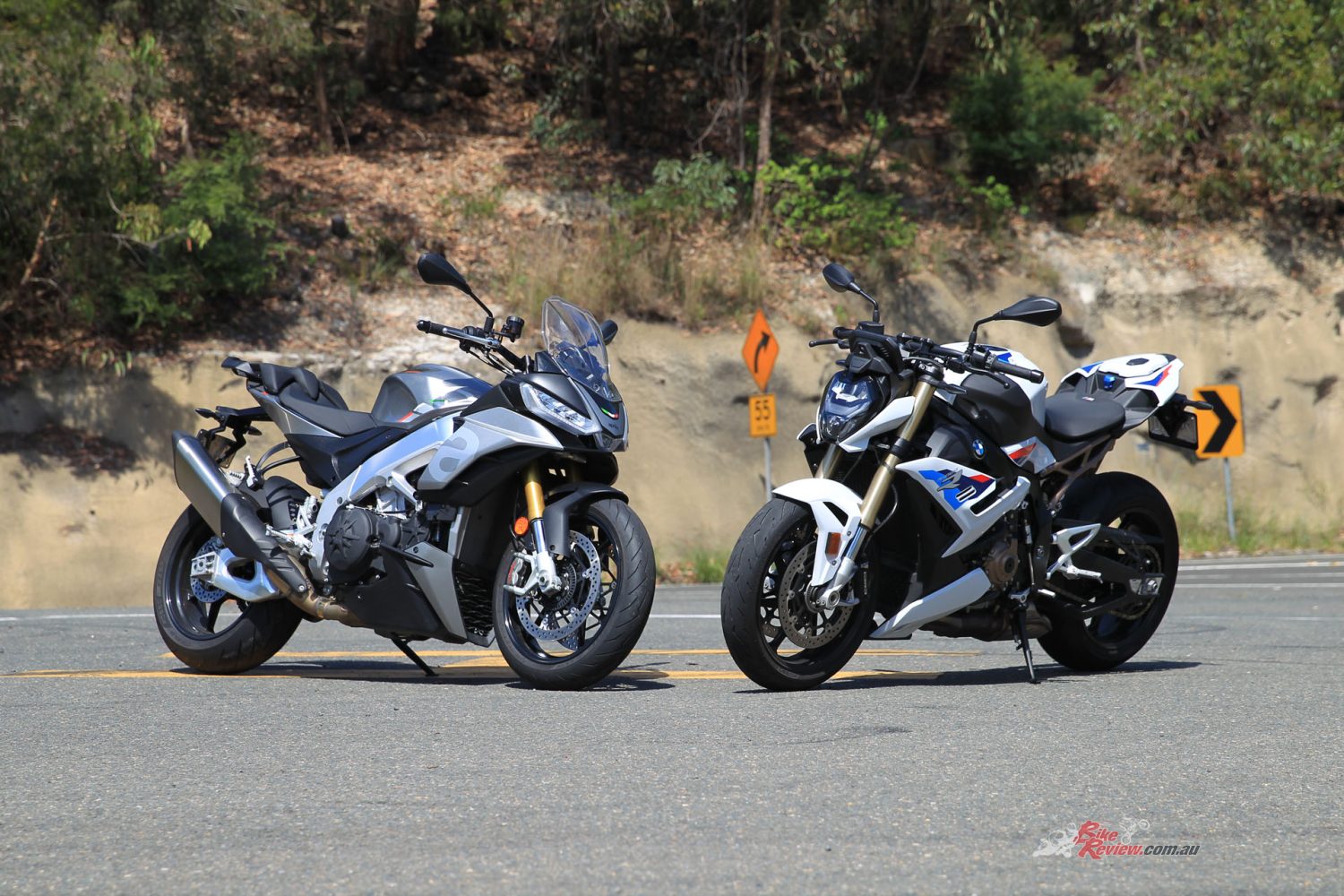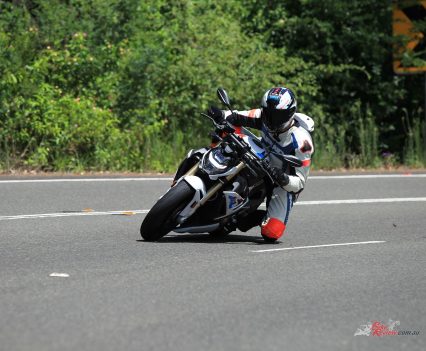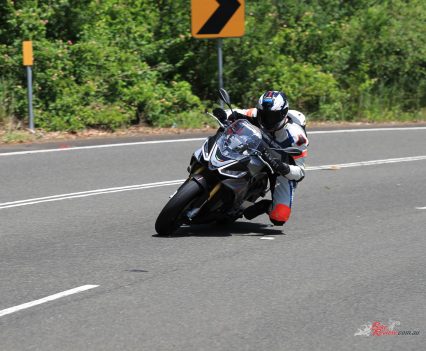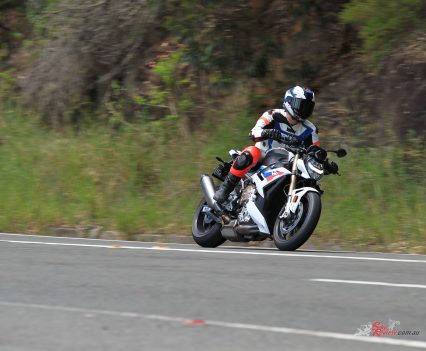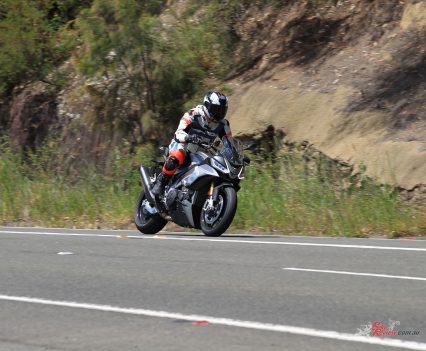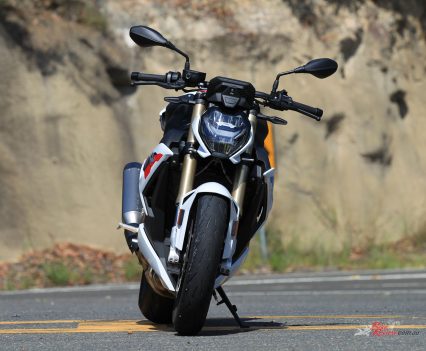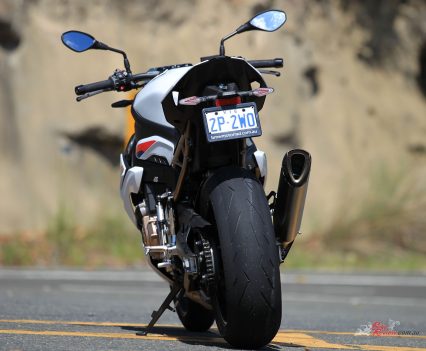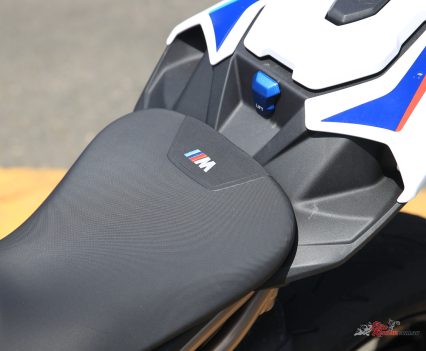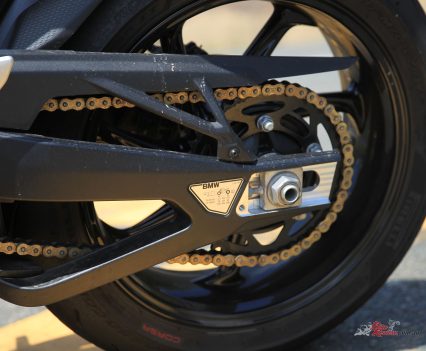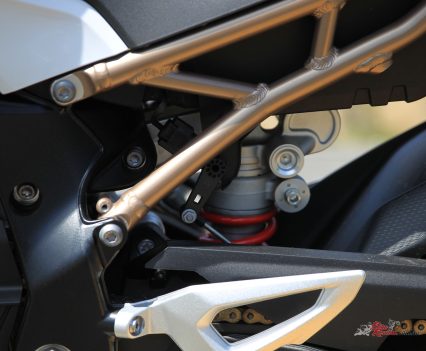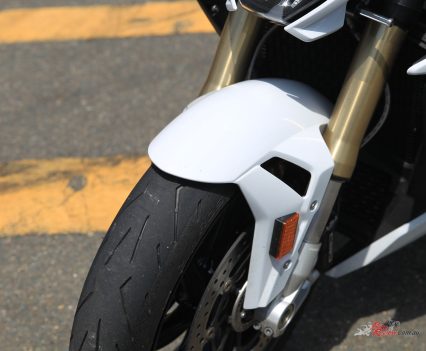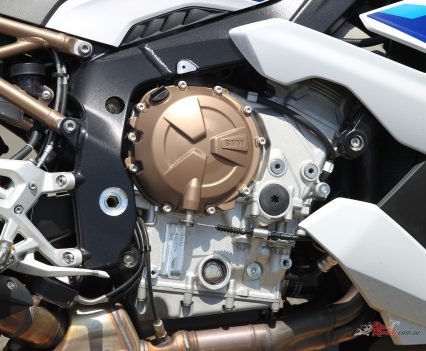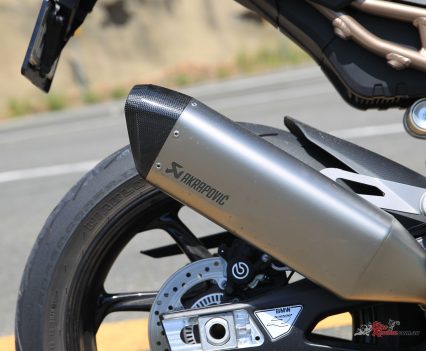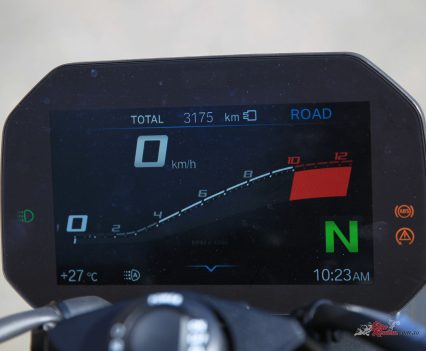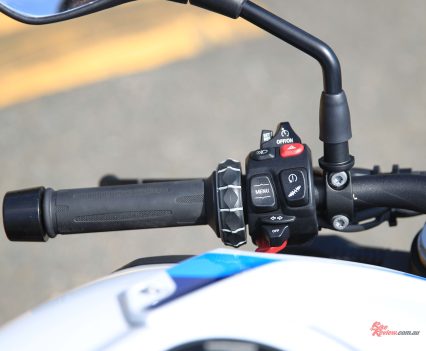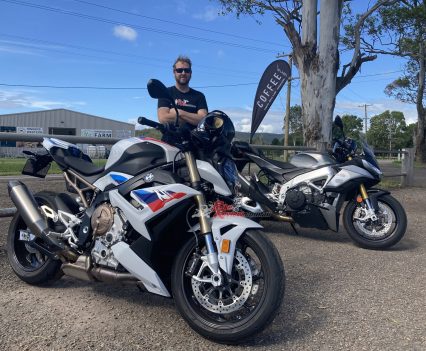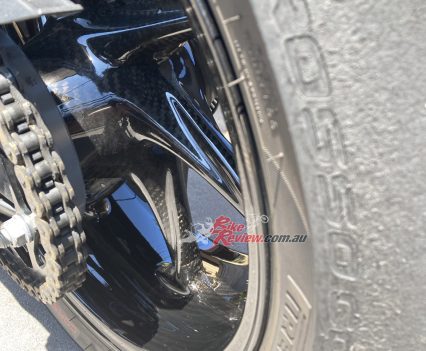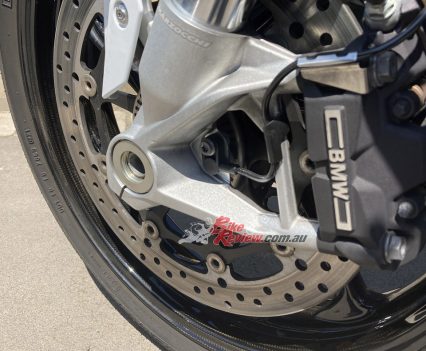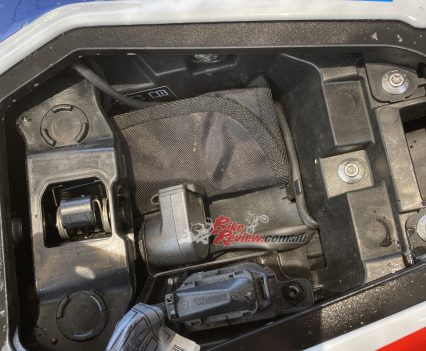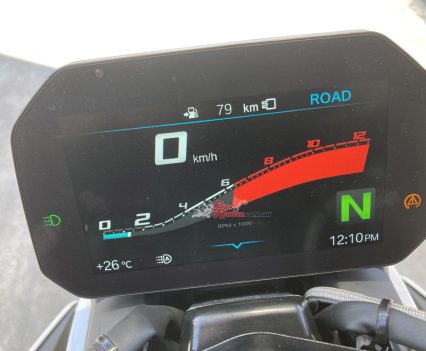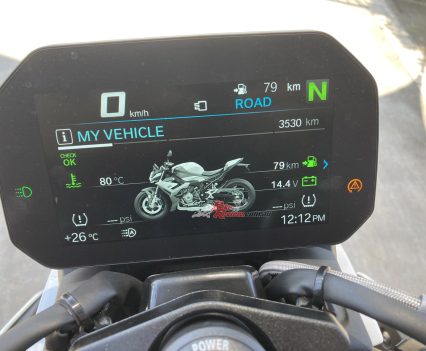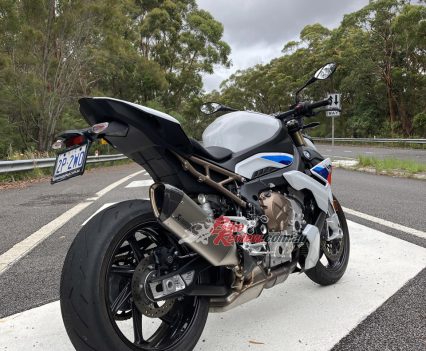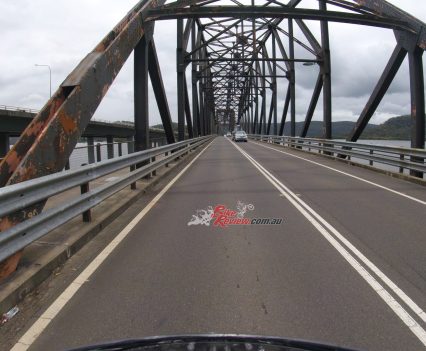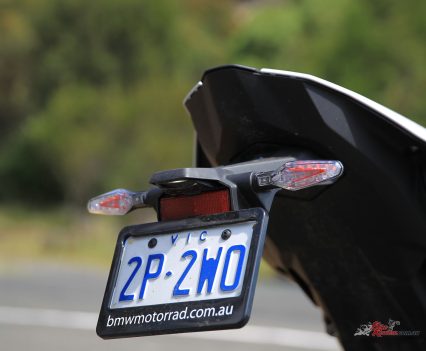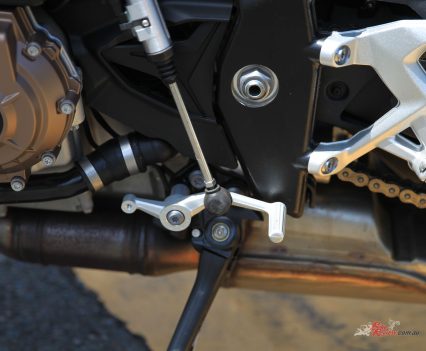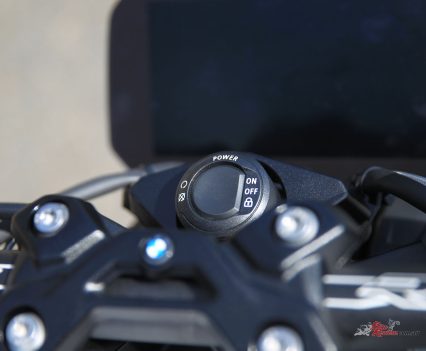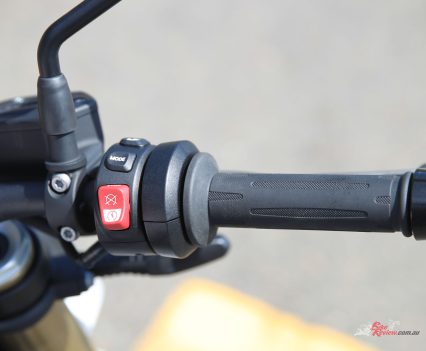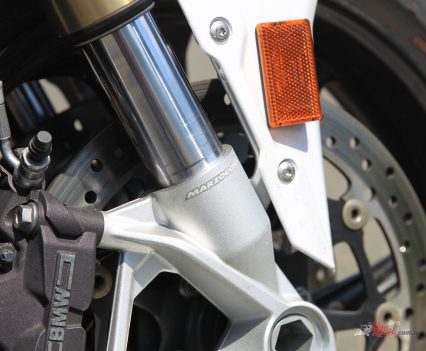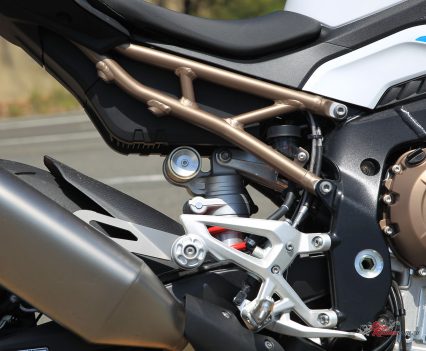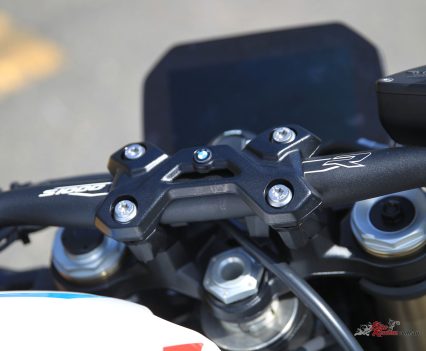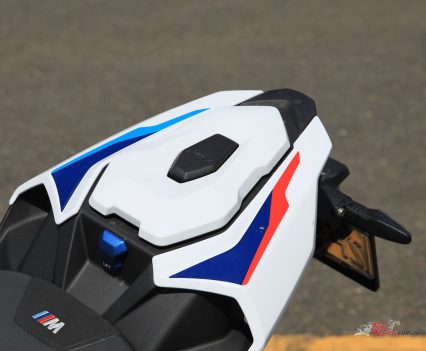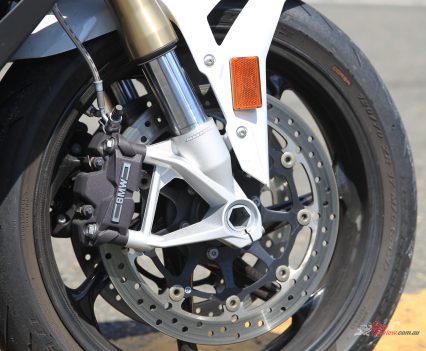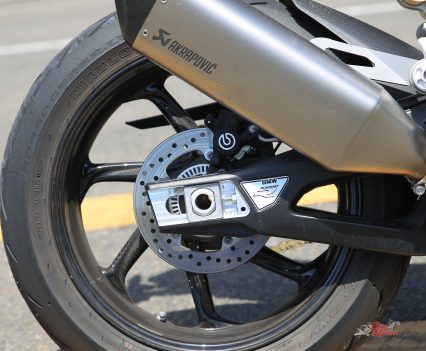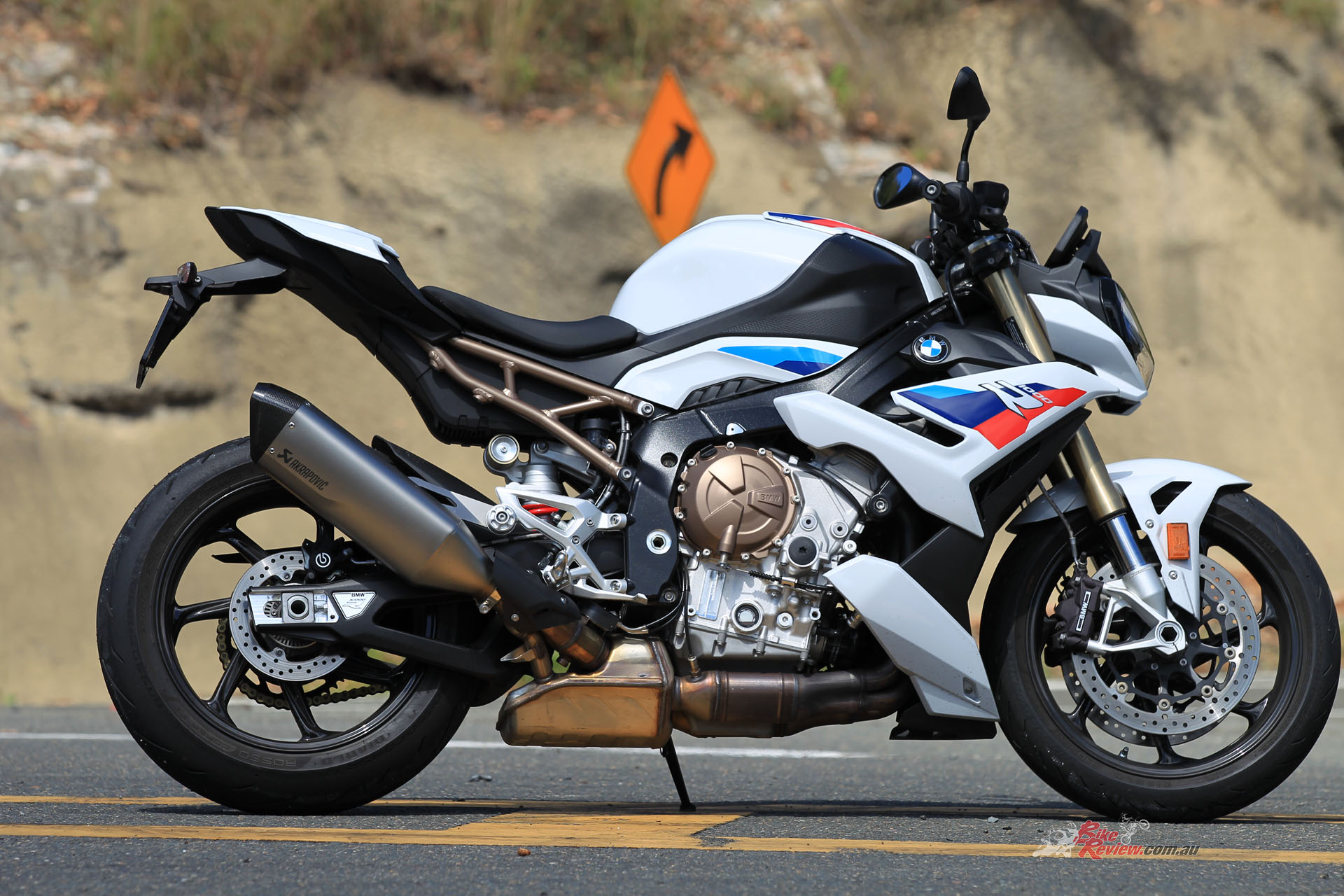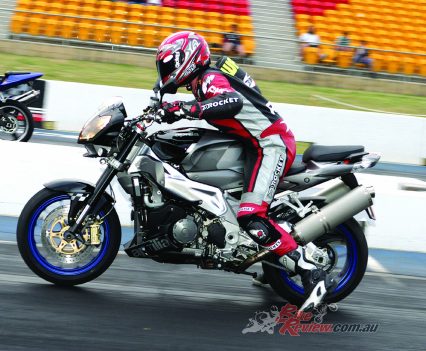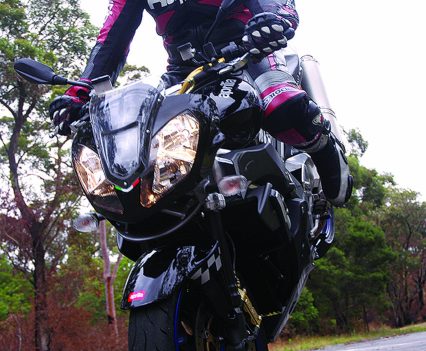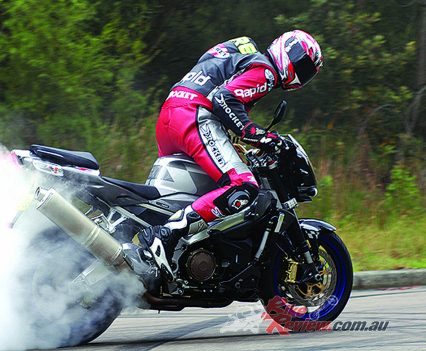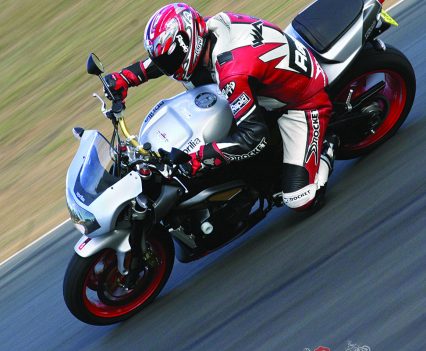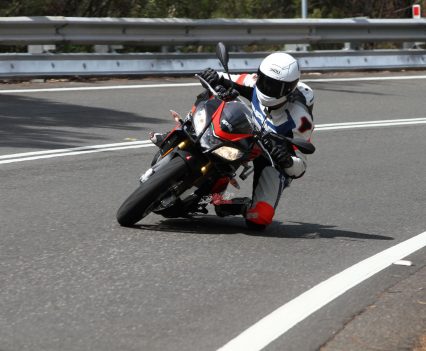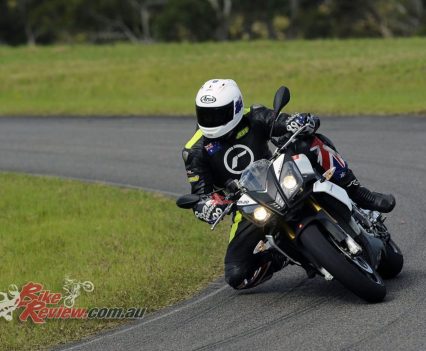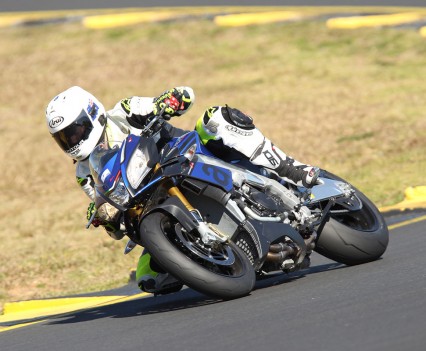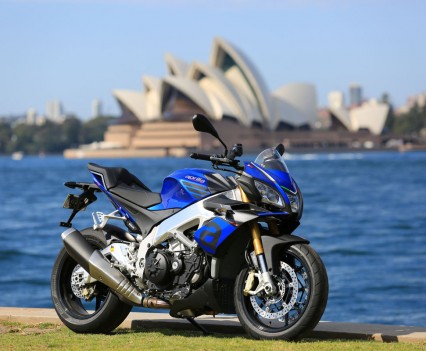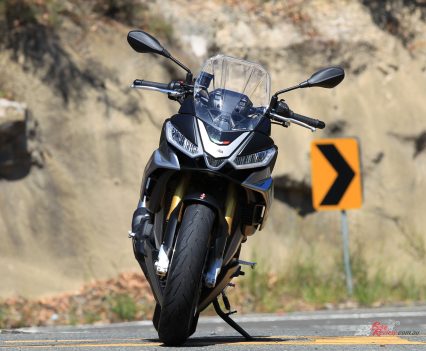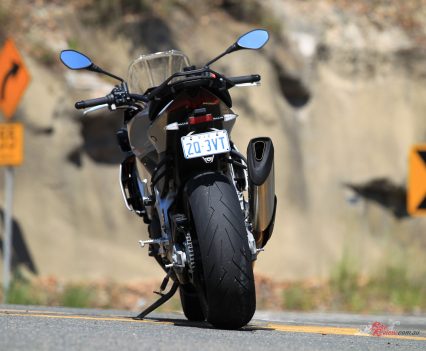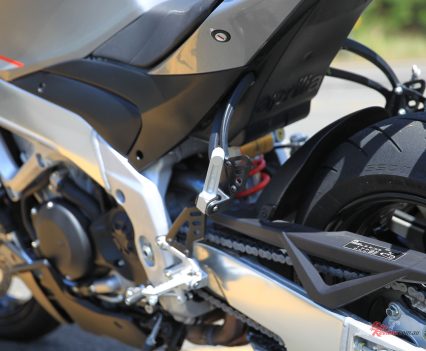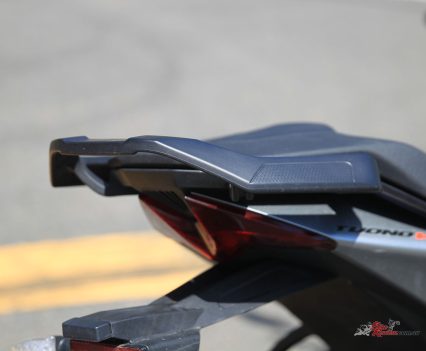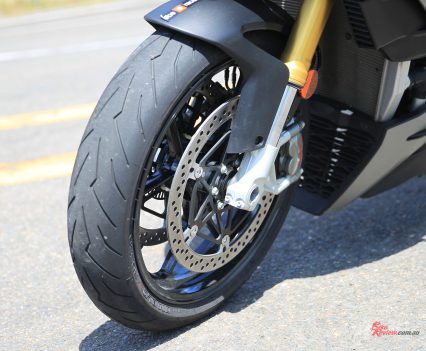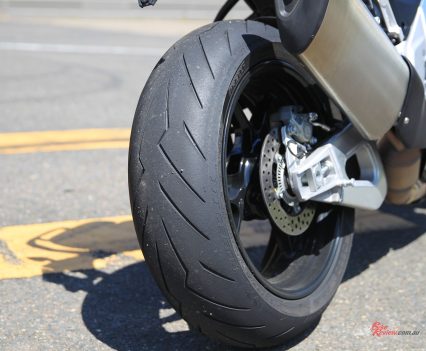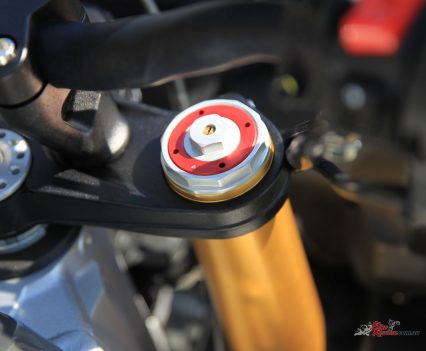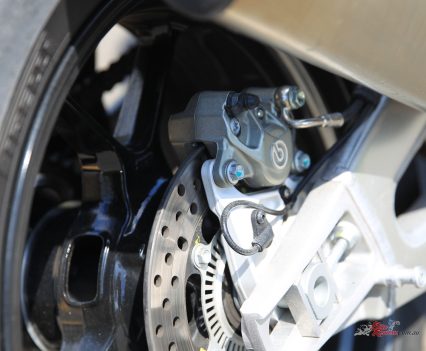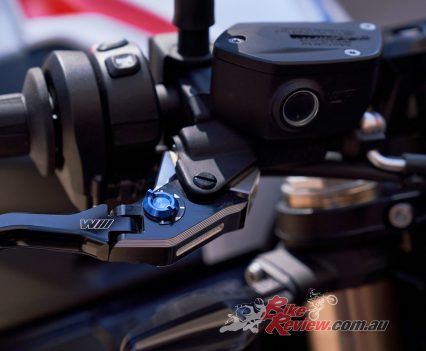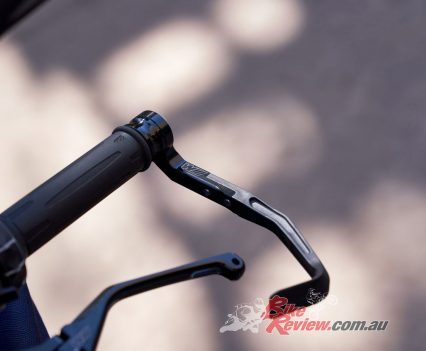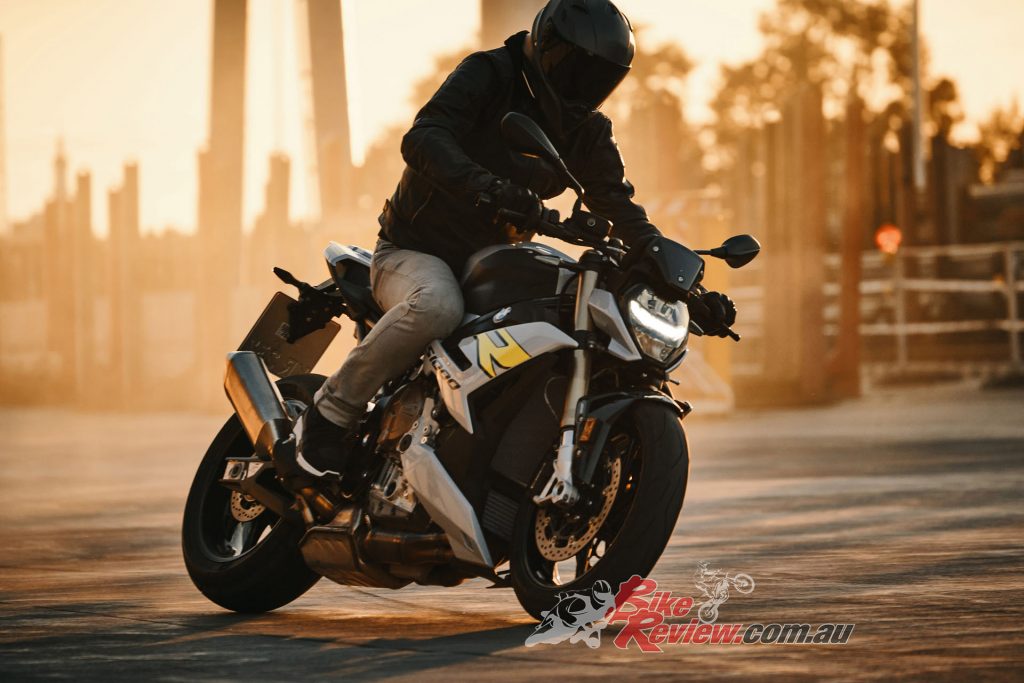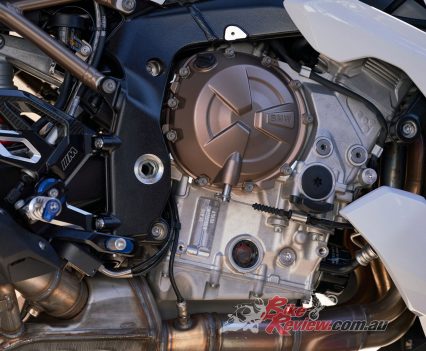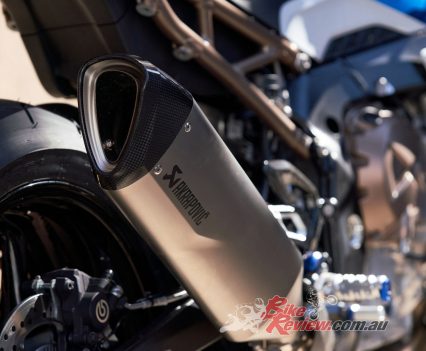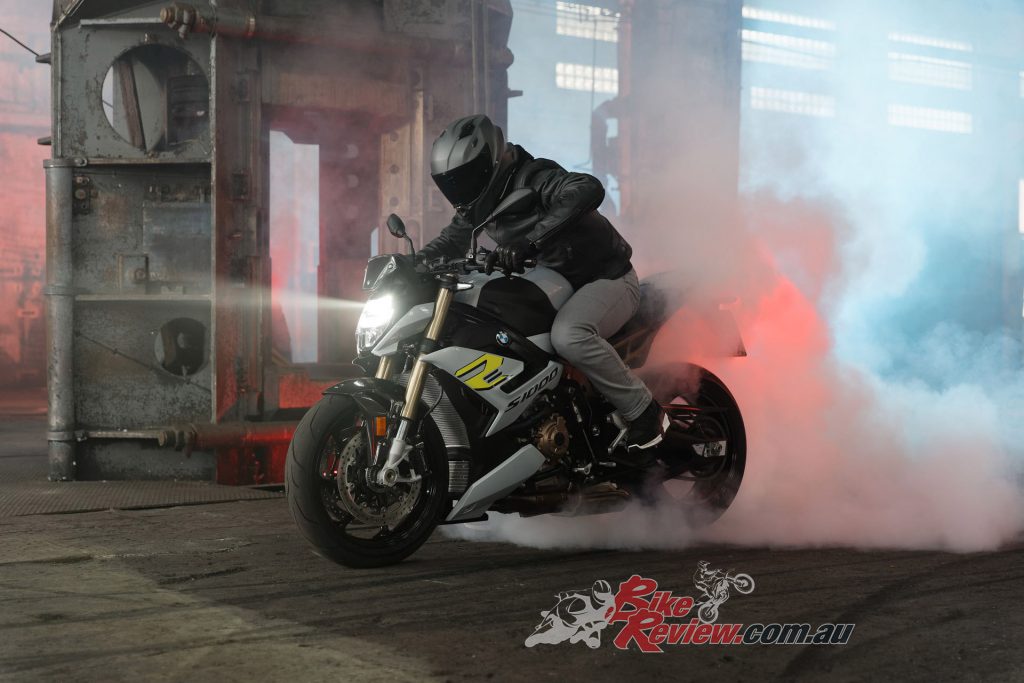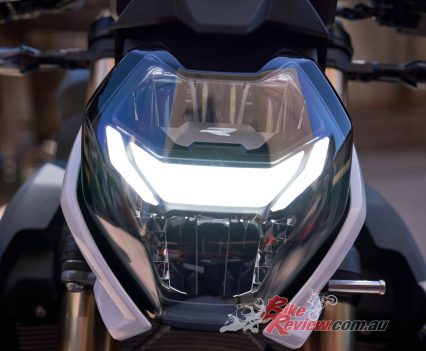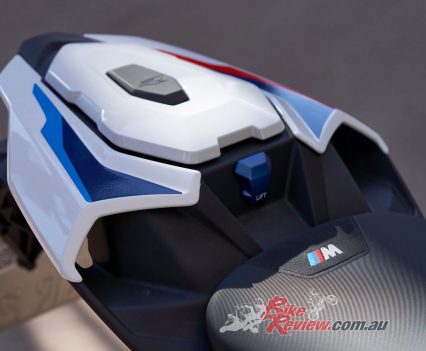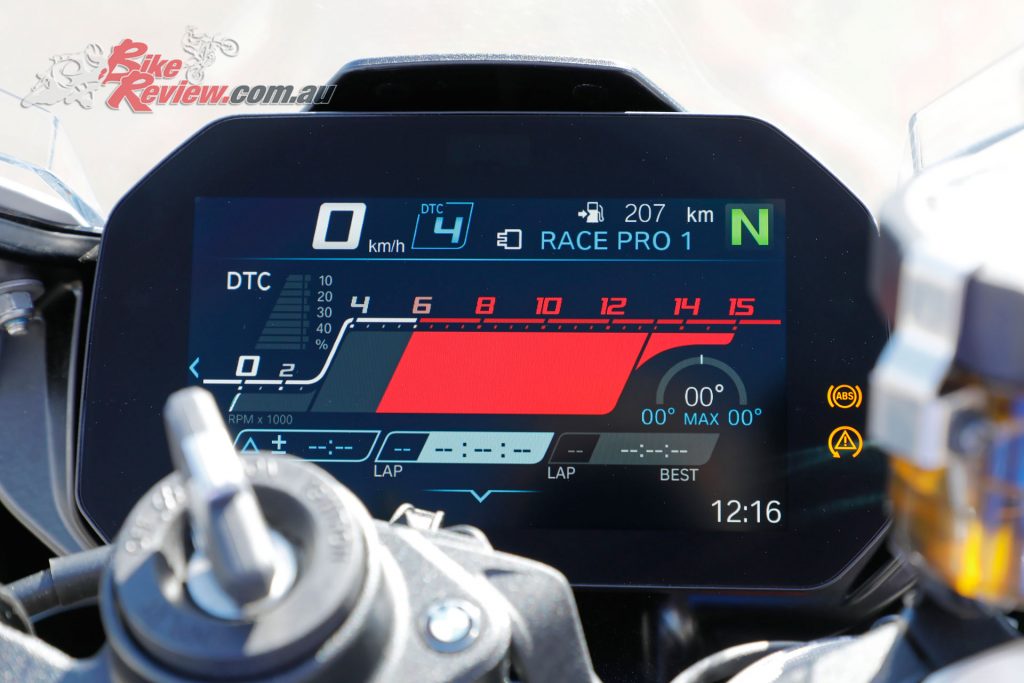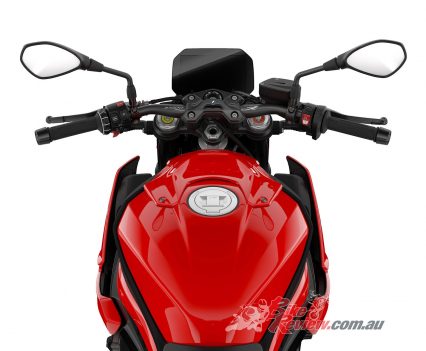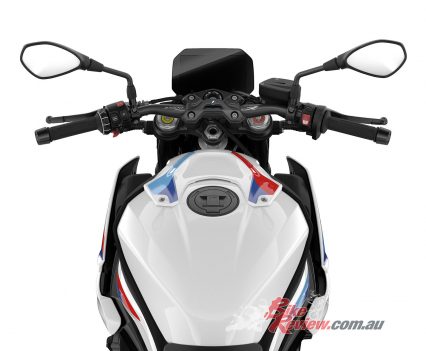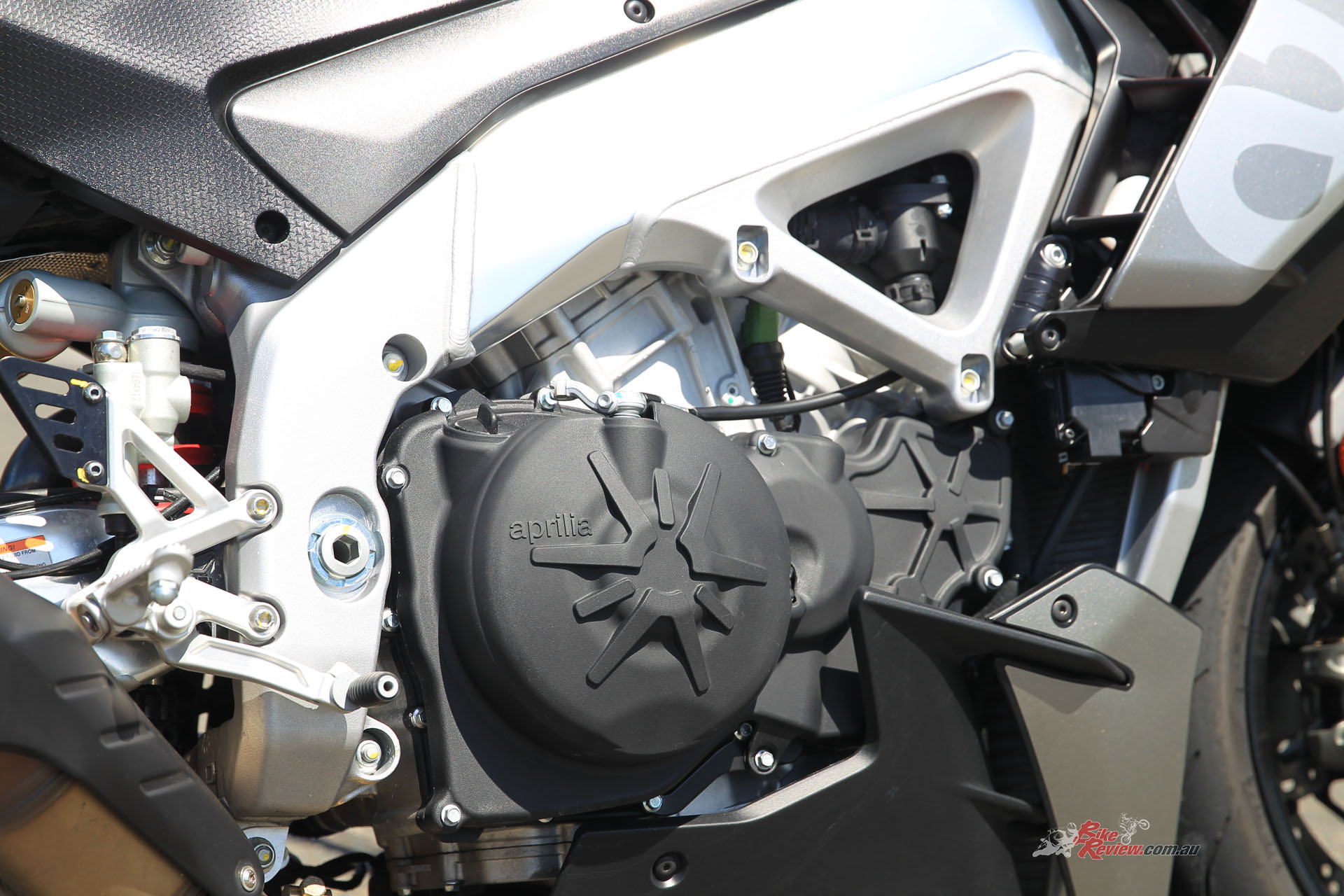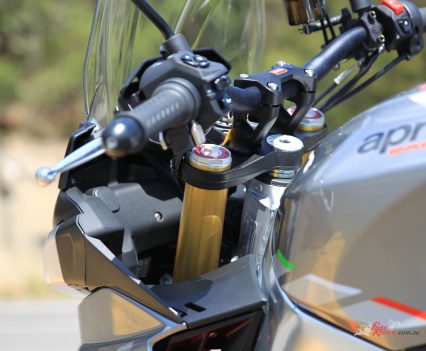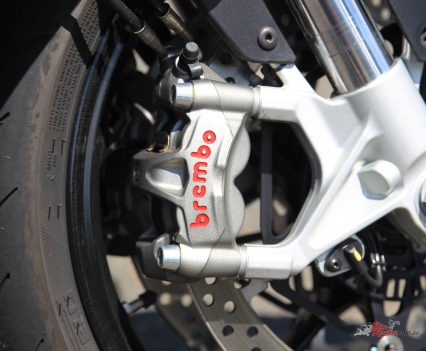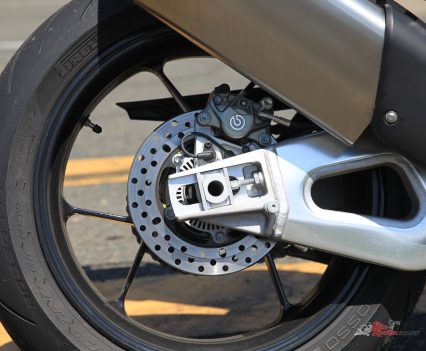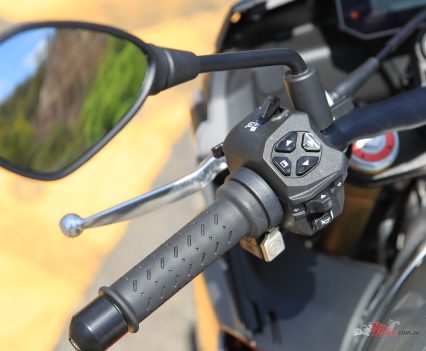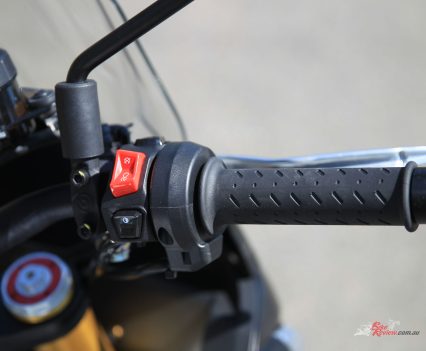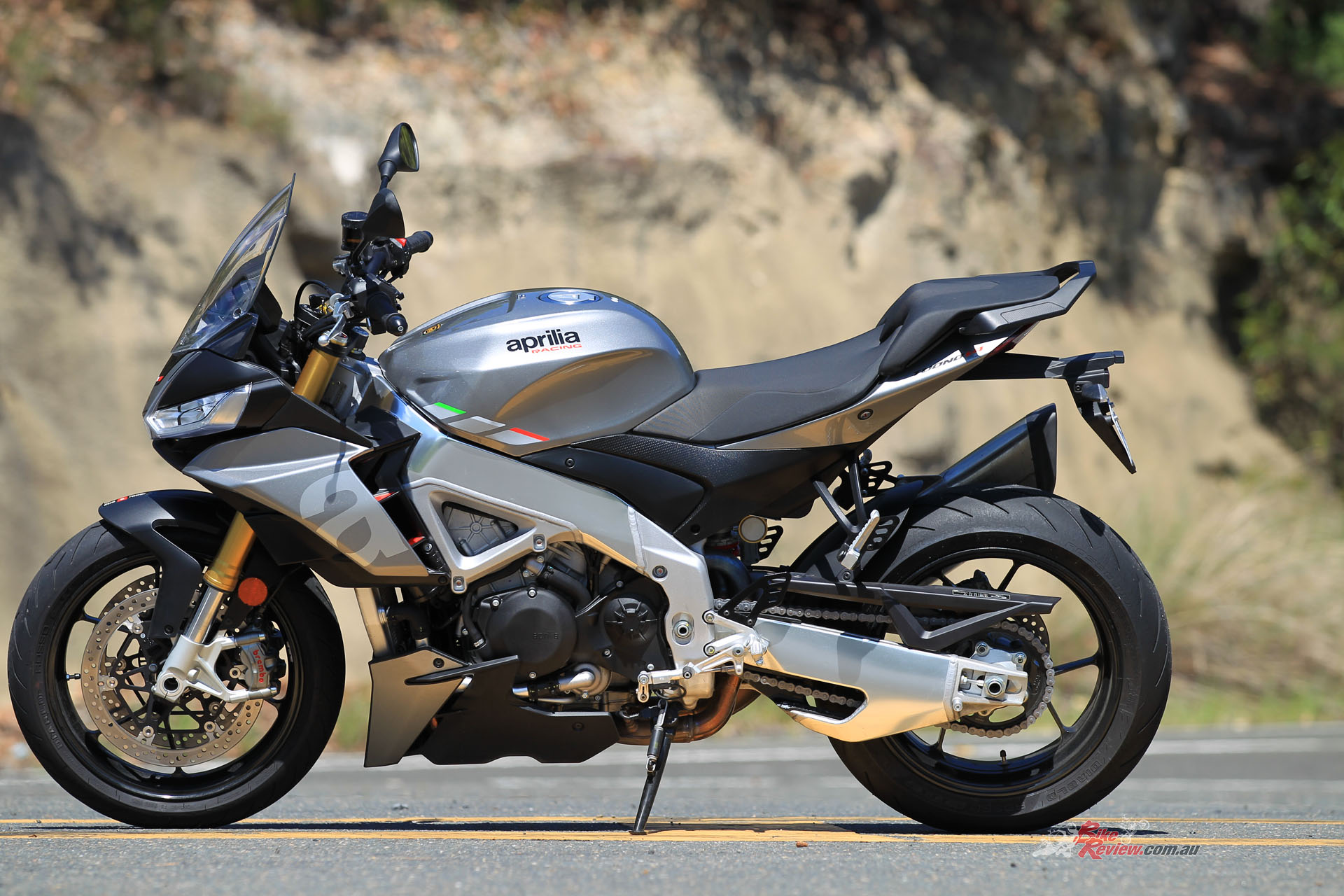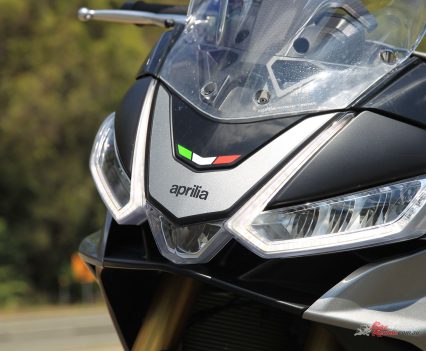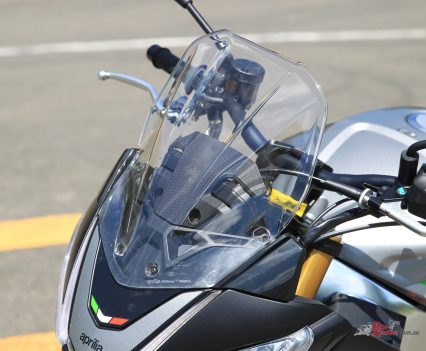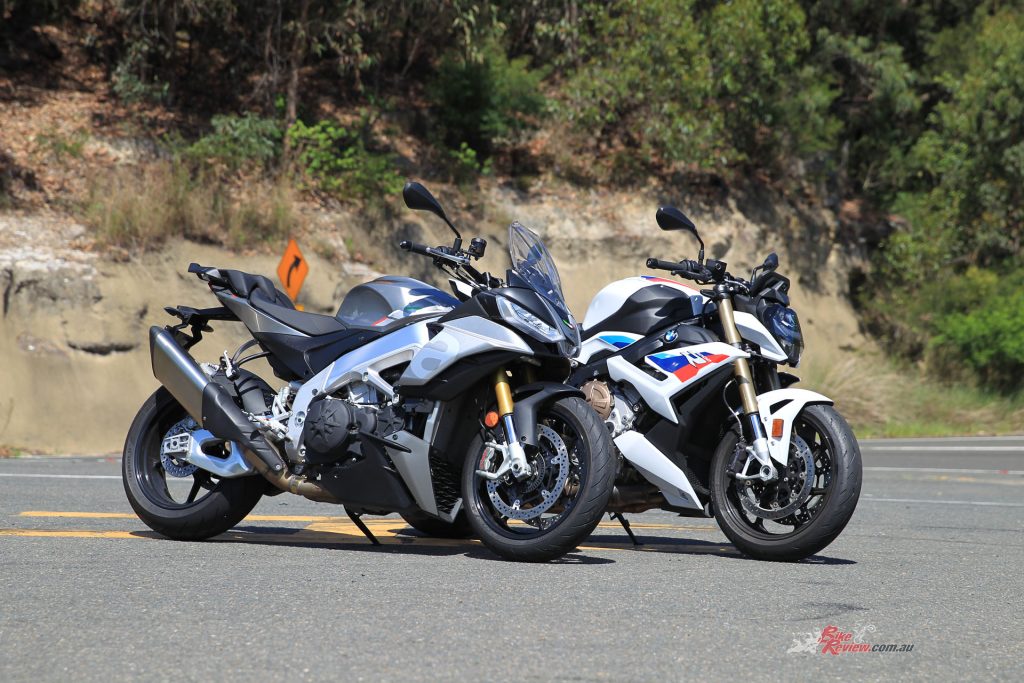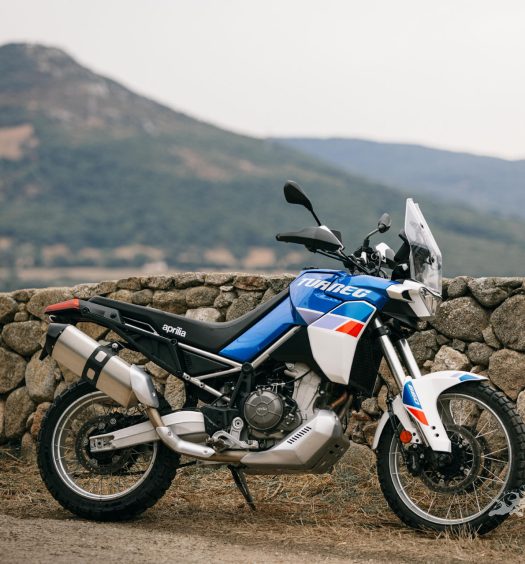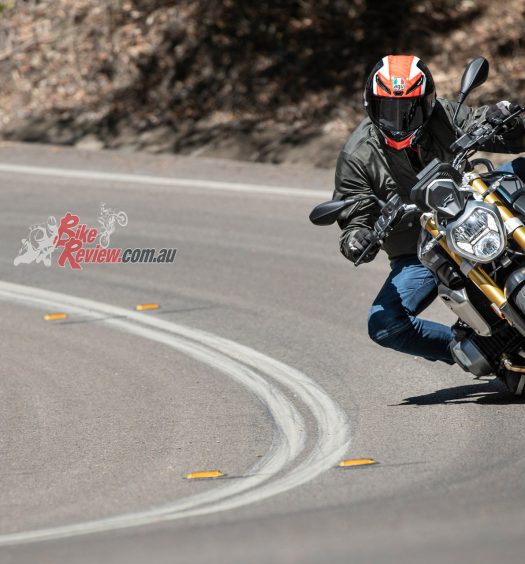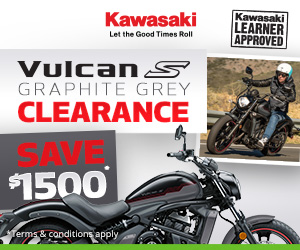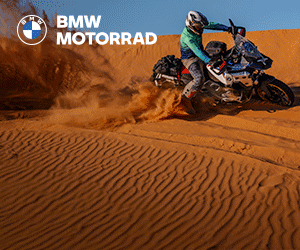Two fast, furious and serious sports nakedbikes. One a refined German inline four, the other a wild Italian V4. Precision versus Passion. Which one is right for you? Photography: Zane Dobie
Earlier this year we reviewed the amazing BMW S 1000 R M-Sport and equally impressive Aprilia Tuono V4 1100. Two extreme bikes from the same class that could not be more different when it comes to riding experience. We put them head-to-head.
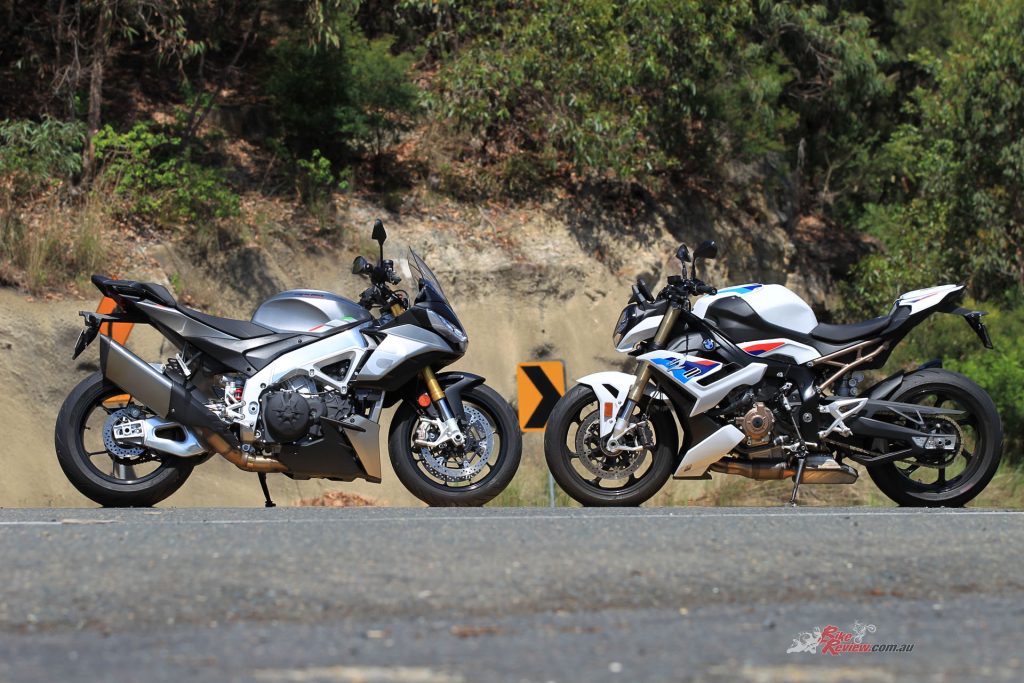
On the left the $28,830 R/A Aprilia Tuono V4 1100 and on the right the $32,930 R/A BMW S 1000 R M-Sport. Italy v Germany. Inline versus Vee. Two very different bikes that produce a similar result…
The new Aprilia V4 1100 has been redesigned for more road going comfort, with roomier ergonomics and soft suspension, a taller screen and more comfy seat to help take the edge off and make the bike more of a long distance option. Still, there is no hiding the wild V4 and RSV4 chassis…
The S 1000 R M-Sport, on the other hand, is still and out and out sports naked. You might be thinking we should have punted the M-Sport against a Tuono V4 Factory, however, the BMW is naturally a fantastic road bike that is, despite spec, less on edge and single focussed than the Factory – so for us, the sensible conclusion is to put it against the V4 1100…
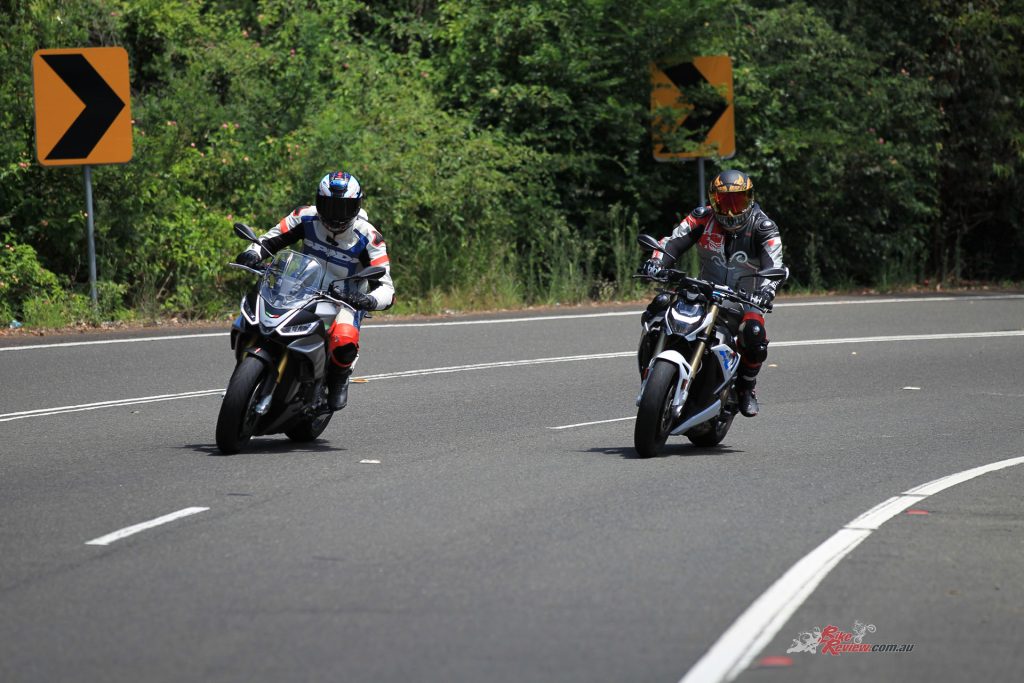
Two different four-cylinder configurations producing very similar power and torque but delivered completely differently. The BMW is smooth and linear. The Aprilia is aggressive and wild. Side-by-side, there is not much in it….
In terms of electronics and tech, the BMW has a slight higher specification than the Aprilia. It also has the DDC (Dynamic Damping Control) while the Tuono has analogue suspension. Engine-wise and chassis-wise they are equal in spec and tech, although the carbon-fibre wheels on the BMW trump the Aprilia’s alloy items, the Aprilia’s top shelf Brembo calipers make up for that over the BMW Hayes units… The BMW is more of a traditional naked, now that the Aprilia has almost a full fairing…
First bike off the trailer is the Bavarian beast, the high spec, lightening fast, inline-four BMW S 1000 R M-Sport edition. We spent a week or so with the bike, including a day riding back-to-back with the Aprilia Tuono V4 1100. The overall individual score for the BMW test was 9.8/10
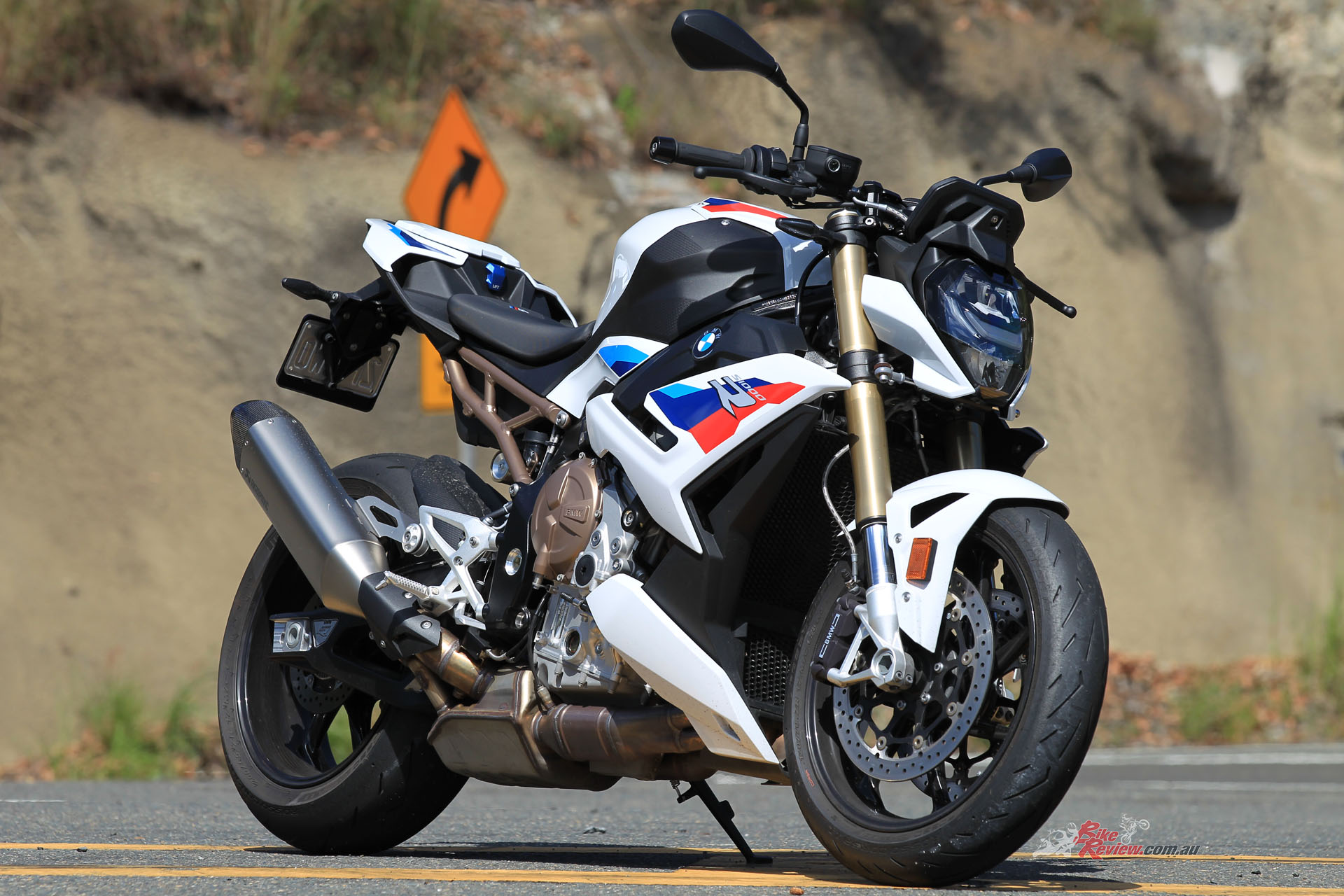
The M-Sport comes with the Comfort Package, Dynamic Package and M Package and is $32,930 ex Sydney Ride Away.
You can read all about the vast amount of updates the S 1000 R got last in the tech breakout below. There are loads of updates that truly bring the S 1000 R even further forward as the ultimate sports naked. It’s faster, lighter, more powerful and more high tech than ever…
The five variants mean there is an option for anyone, but of course BMW Motorrad offer almost limitless customising options for any prospective new owners should extra optioning be required. The M-Sport as tested comes in at just a shade under ten grand more than the standard S 1000 R’s price tag of $23,075…
The standard model S 1000 R features ABS Pro, Race ABS, DTC, Dynamic Brake Light, LED lights all-round, TFT dash, Riding Modes, Hill Start Control, Drop Sensor, Passenger Kit and a USB socket in addition to the normal specifications but the R Sport gets Adaptive Headlight, Daytime Riding Light, Headlight Pro, Tyre Pressure Monitor plus the Comfort and Dynamic Packages.
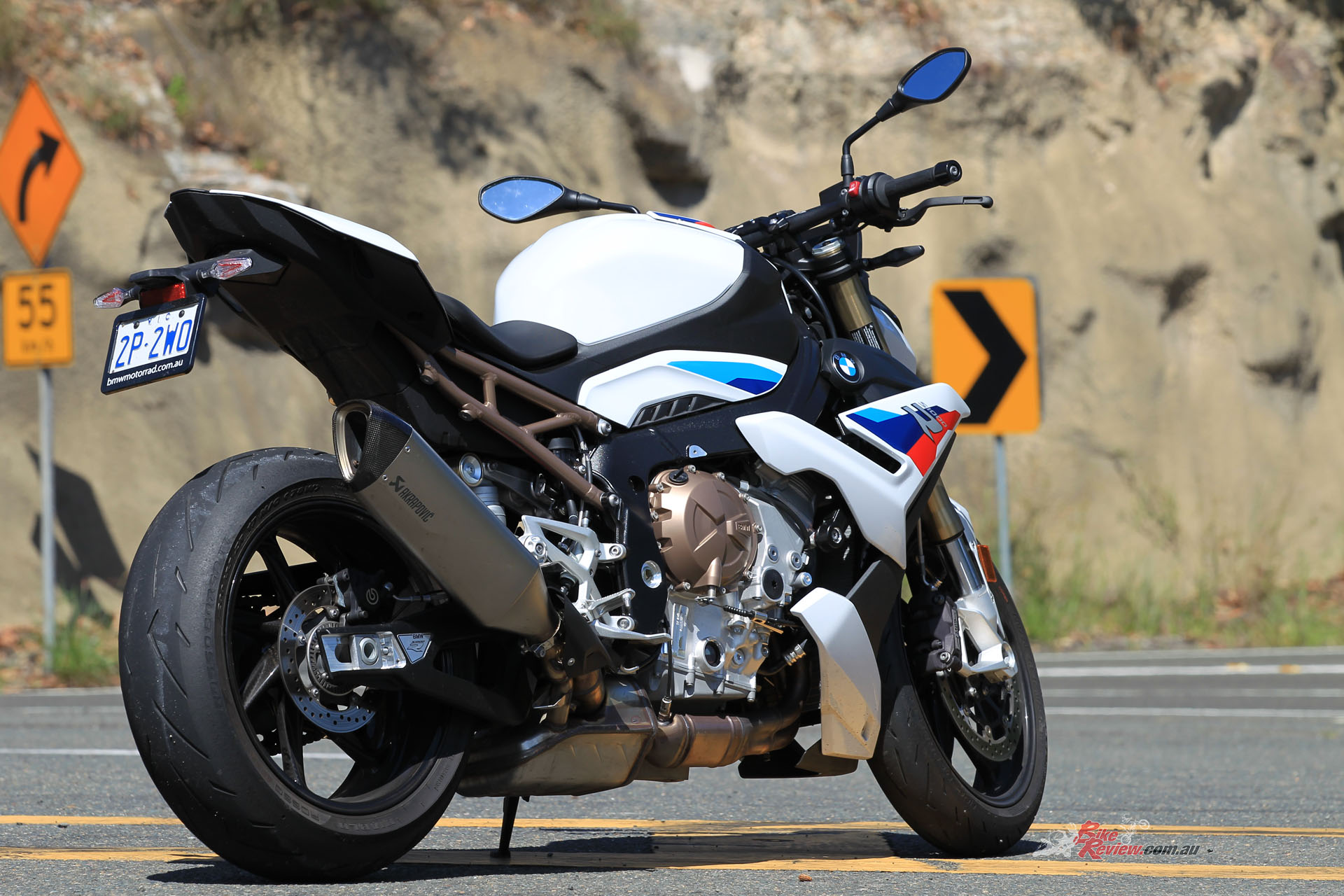
Looking good from any angle, the M-Sport is a lot of money but you get a hell of a lot of motorcycle…
The R Race gets the same plus M chain, battery and forged wheels and a sports muffler. The R M-Sport gets all of that stuff as well as M Endurance Chain, M GPS-Laptrigger, Sports Silencer, M Sport Seat, M Battery, M Carbon Wheels while the top shelf R Clubsport gets the M-Sport goodies plus a Carbon Package, M Billet Pack, and an alarm. Got all that? Click here to learn about the packages…
Every now and then a motorcycle comes along that leaves a lasting impression. It could be a mind blowing engine, a sublime chassis, looks to die for or just an overall package of perfection… but these bikes, they don’t come along all that often. In fact, in two decades of reviewing bikes I can count on both hands the number of extra special machines… And now the S 1000 R M-Sports is one of them.
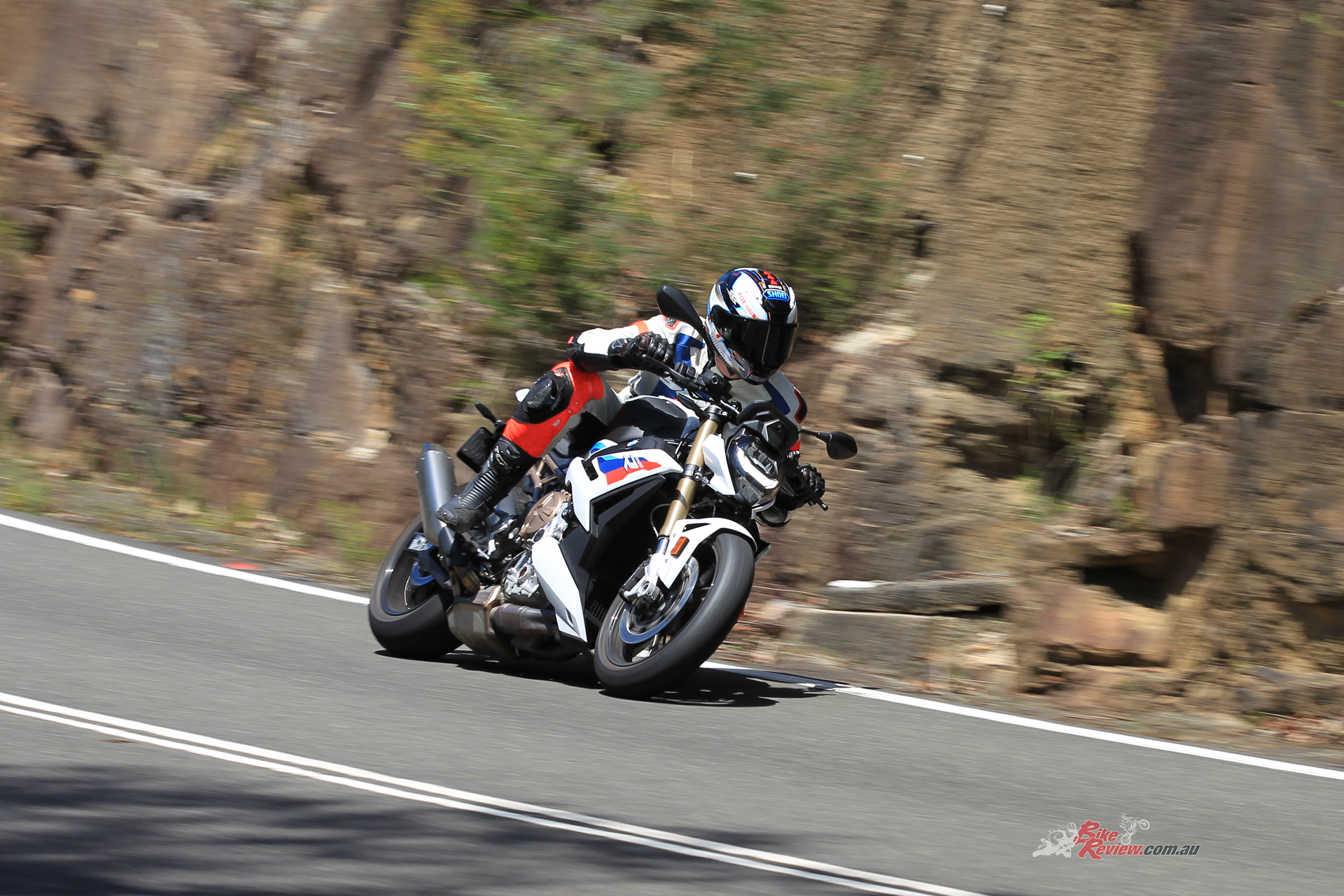
Handling can only be described as sublime. Everything about the S 1000 R M-Sport just gels to perfection.
My week with the S 1000 R M-Sport began with a ride through the local hills and countryside with Andrew Jenkin, who was onboard the new Tuono V4. We were doing a comparo ride (you can read our Tuono and S 1000 R M-Sport comparison story here), not so much a head-to-head as the Beemer way out does the Aprilia in spec, but more of a V4 or inline-four naked deal. It was a great day and one thing stood out like a Bavarian Cheesake – that is, the S 1000 R M-Sport is an angry beast!
It might have creature comforts and BMW luxury touches but this bike is pure performance…
It might have creature comforts and BMW luxury touches but this bike is pure performance and not for the long haul trip around Australia or for the faint hearted. It means business, no matter the Ride Mode, and the more you give it the more angry it gets. It is without a doubt the fastest inline-four nakedbike I’ve ridden…
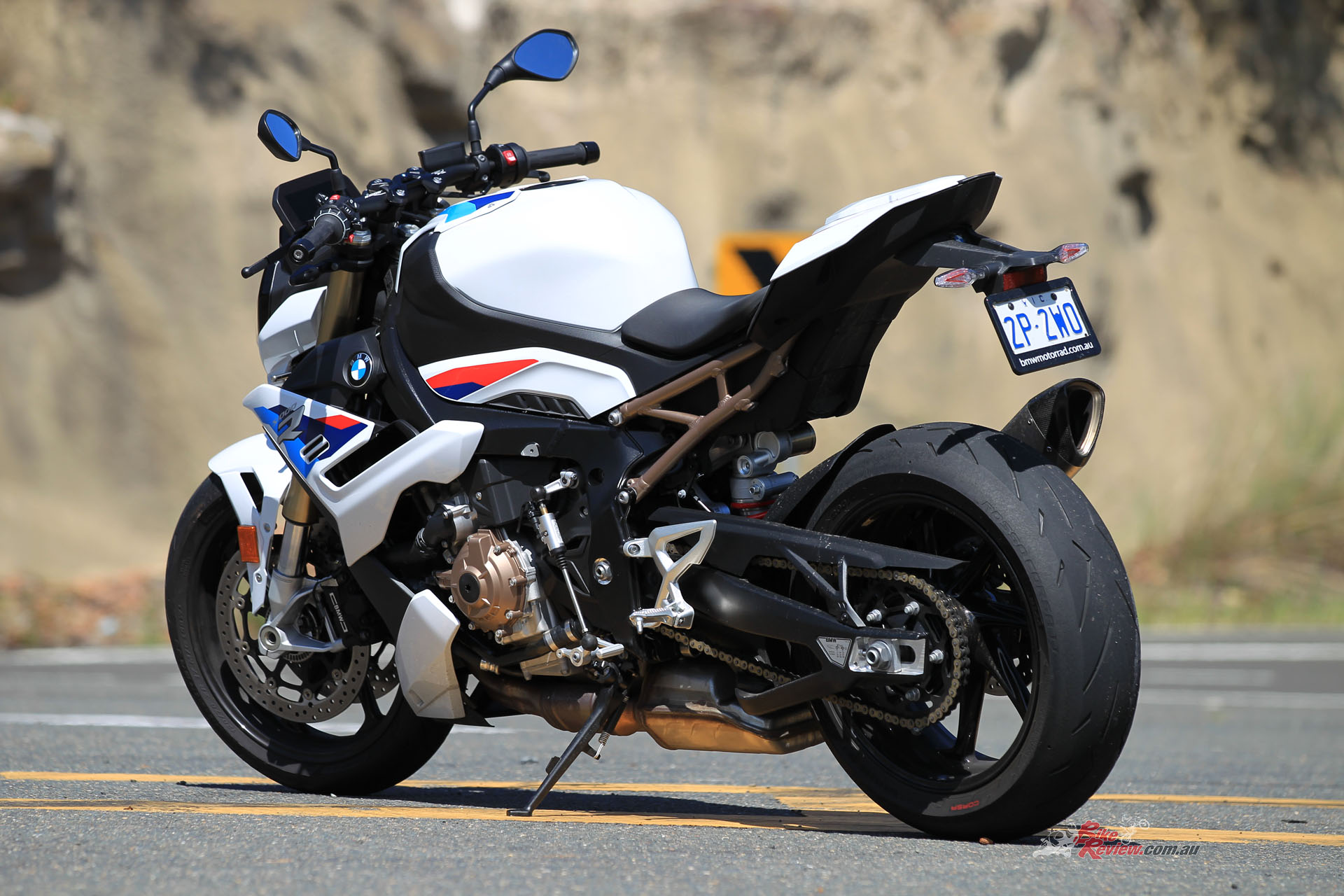
The S 1000 R now has the same chassis and engine as the 2019-onwards S 1000 RR, and it shows. It’s wild.
The new S 1000 R has amazing, linear torque and perfect power delivery from idle to the rev limiter. It’s not instant, explosive response but more a controlled build of huge horsepower and torque. And in that mid-range area, wow, the M-Sport has some very serious go. With the same upgrades as the 2019-onwards S 1000 RR (full review here) but with tuning for more mid-range, the new R has 121kW (165hp) at 11,000rpm. Maximum torque of 114Nm is available at 9,250rpm, so it’s broader and gruntier than before. It also has taller top three gears for more relaxed highway use… Broadening the spread of power even further.
The standard model comes with the usual three Ride Modes – Rain, Road and Sport, but the M-Sport has Dynamic and Dynamic Pro as well, plus the Ride Modes are linked to the DDC so that not only are you getting engine maps, you are also getting suspension behaviour to suit. It’s a fantastic system and very refined these days. In fact, I would not bother to create any customised versions, BMW have the presets spot on, although I didn’t ride it on track and Dynamic Pro may still be a bit soft there.
I spent most of the time in Road, as a lot of my riding was daily duties. I also did a few wet weather rides in Rain, which helps tame things down, but when going for it, I generally chose Dynamic or Dynamic Pro, as I found the DDC still gave a compliant enough ride on the rough roads, but I enjoyed the extra engine response and the wild popping on back-off that Dynamic Pro gives. It sounds horn! Throttle response is amazing, acceleration incredible yet the engine control is intimate and sublime.
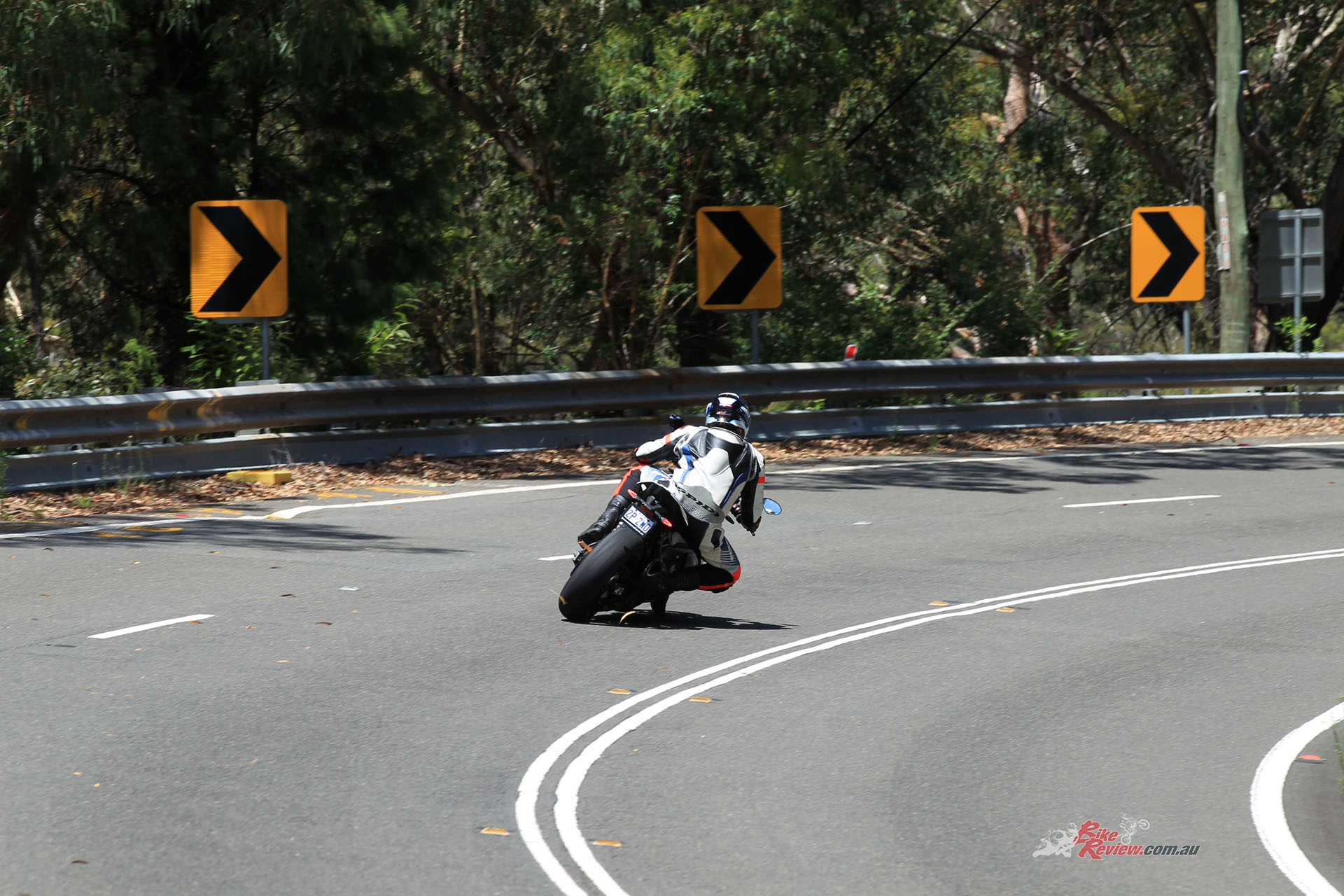
The new swingarm, shock position and linkage makes the rear of the S 1000 R hook up like it is glued to the road.
The gearbox is perfection, with super slick shifts from the quickshifter making it a breeze to work up or down the gearbox. BMW’s Quick Shift Assist Pro is one of the best systems out there if not the best. They were early adopters of the quickshifter and certainly have the experience to create such a refined and reliable system as they have.
The ratios are good, with first not too tall that you need to slip the clutch for ten kays, and rapid enough acceleration through second and third. I didn’t notice the fourth and fifth changes and sixth gear did have the revs lower at highway speeds but the vibes were still enough to blur the mirrors.
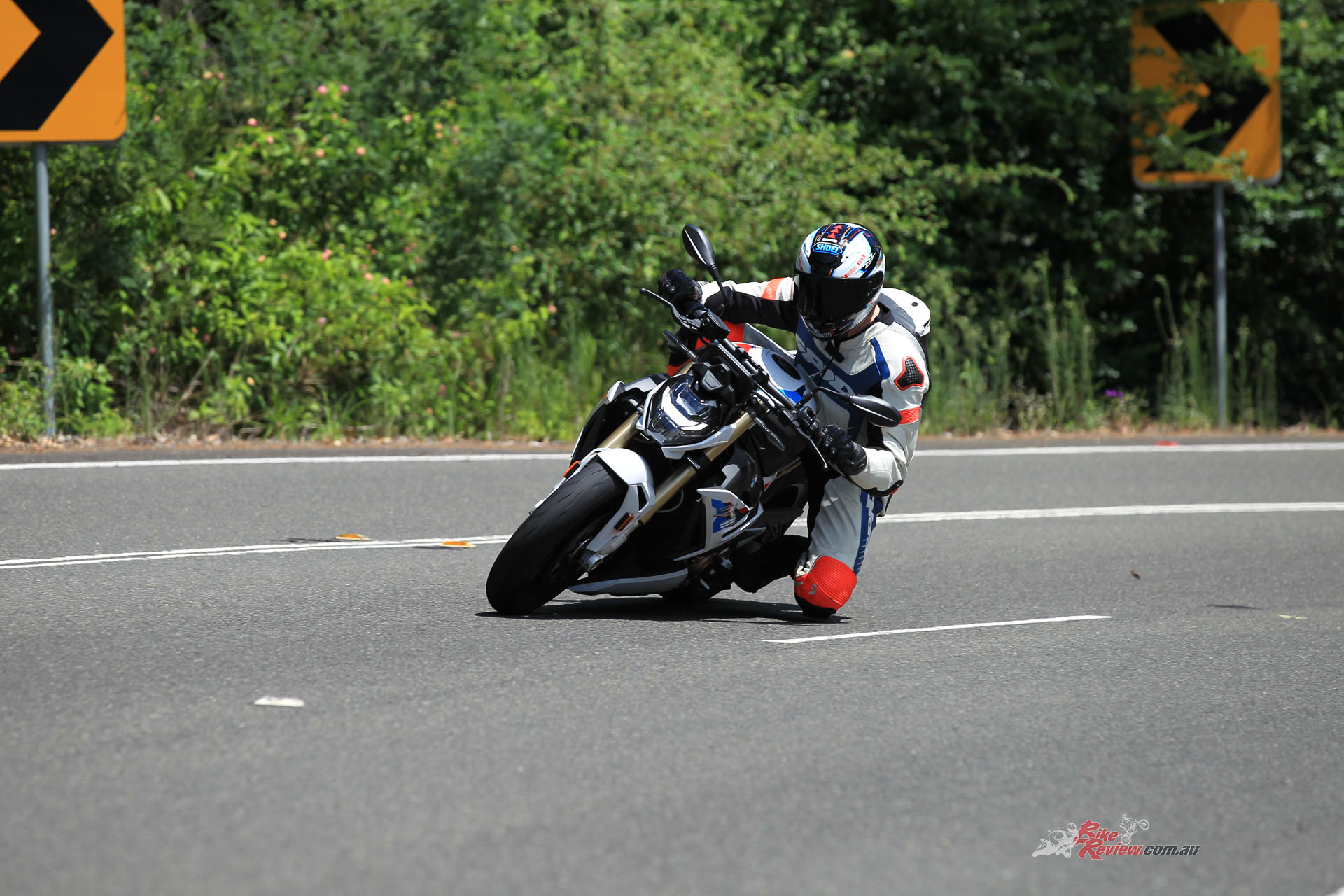
Power, handling, looks, cutting-edge electronics and you have a hell of a good package up in the hills!
With the new S 1000 R born slipper clutch and Engine Drag Control, rolling into turns from any speed, whether hard on the brakes or off the brakes altogether, is silky smooth, with the engine not upsetting the chassis at all, no matter how rapid the backshifting. Overall, the engine is an absolute cracker, with that smooth build of power off initial throttle opening, then the four-cylinder reward of rapid revs and mega mid-range to top-end. The only gripe? The motor vibrates like hell through the ‘bars and ‘pegs from 6000rpm, but it’s not a deal breaker, at least not for me.
The chassis, as expected being a superbike frame, swingarm and running gear, is amazing. Again, with well over a decade to refine the S 1000 RR, BMW know what they are doing, and the transition to the S 1000 R for the latest generation has worked. The Flex-Frame offers intimate feel and feedback, not MotoGP stiffness, while still handing out flickability and accuracy. It’s a best of both world’s situation and combined with the top shelf suspension components and the DDC technology, it’s actually mind blowing how good the S 1000 R M-Sport handles…
The mechanical grip at both ends is extraordinary, and combined with the sensational Pirelli Diablo Rosso Corsa II tyres, the M-Sport is truly on rails. With the upright, roomier ride position and wide ‘bars, plus responsive reactions to footpeg inputs and weight shifting, flicking the S 1000 R from corner to corner is a breeze.
For me, I prefer it to the S 1000 RR handling and ease of riding on the public roads. Everything fits me, from the reach to the handlebars to the seat-footpeg distance and the general rider triangle. It’s stable, too, even hard on the gas off bumpy corners there is not even a wiggle at the ‘bars.
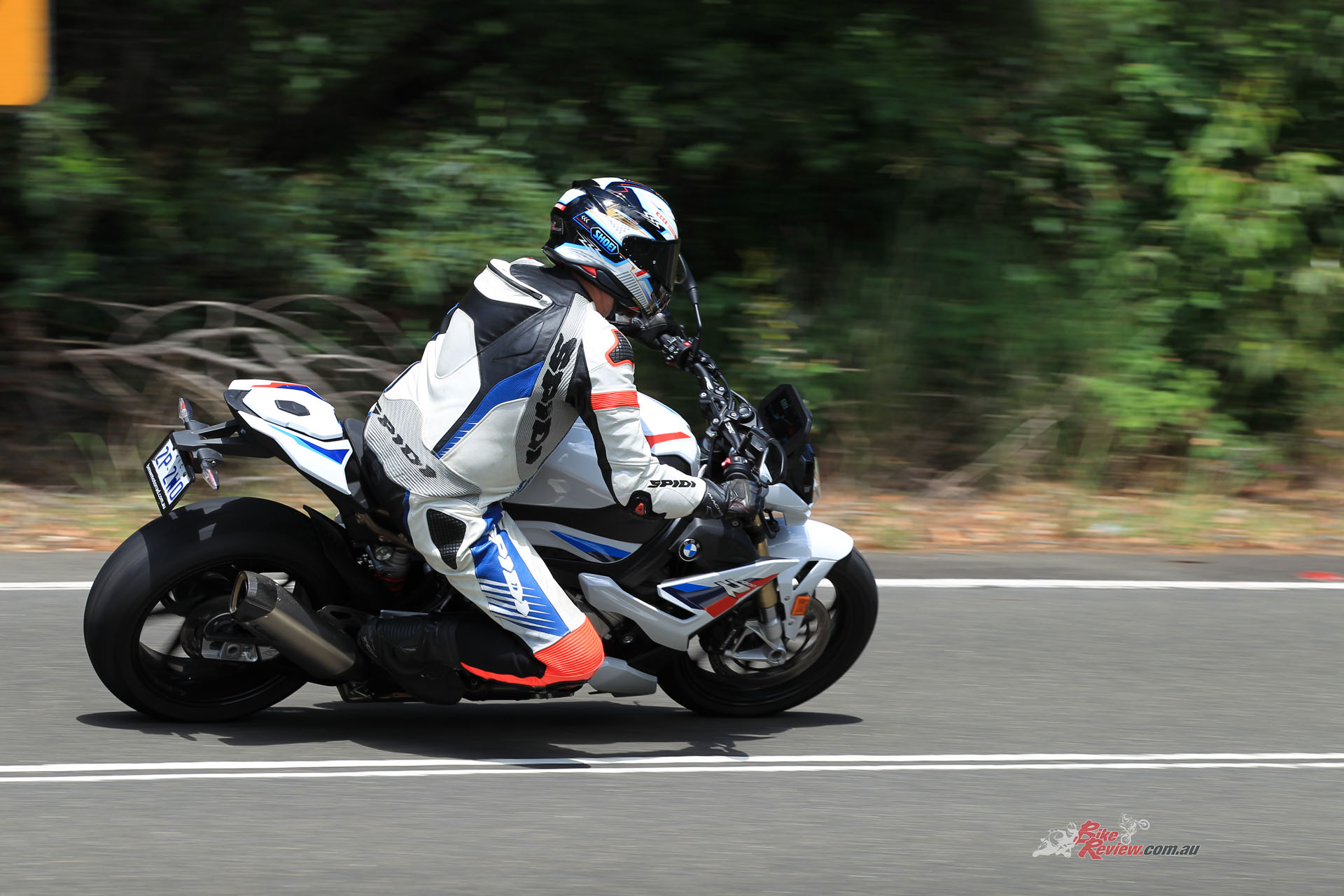
“The mechanical grip at both ends is extraordinary, and combined with the sensational Pirelli Diablo Rosso Corsa II tyres, the M-Sport is truly on rails.”
Braking is something BMW know how to do but on the latest S 1000 RR, the switch from Brembo to Hayes calipers was, in my opinion and experience on track, a backwards step. However, on the naked S 1000 R, in road sports conditions, I can’t fault the brakes. Despite only having a conventional master-cylinder not a radial-pull one, they have immediate but not intimidating initial bite, incredible power, and fairly good feel. Not top spec Brembo feel, but not too far off it.
The S 1000 R M Sport Edition is one hell of a motorcycle. Perfect power delivery, from idle to the rev limiter. In Dynamic Pro, it’s the quickest and best handling nakedbike I’ve ever ridden. Sublime steering. Intimate feel. Incredible brakes. And the best sounding, particularly the pop on the back shift. Wow… it’s an angry beast. And it looks amazing in Light White/M Motorsport. Go and try one!
2022 BMW S 1000 R M Sport Specifications
Price: From $23,075 Ride Away ($32,930 R/A as tested)
Configure your bike and price here
Claimed Power: 121kW[165hp]@11,000rpm
Claimed Torque: 114Nm[@9250rpm
Wet Weight: 194kg (with carbon wheels)
Fuel capacity: 16.5L
Fuel Consumption: 6.2L/100km
Engine: Liquid-cooled in-line four-cylinder engine, 999cc, DOHC, 80 x 49.7mm bore x stroke, 12.5:1 compression ratio, valve activation via individual rocker arms, variable intake camshaft control system BMW ShiftCam, Gearbox: Constant mesh six-speed with quickshifter Clutch: Self-reinforcing multi-plate anti-hopping wet clutch, 525 chain 17/45 gearing.
Chassis: Aluminium composite bridge Flex-Frame frame, load bearing engine, aluminium underslung double-sided swingarm. Rake: 65.8º Trail: 96mm
Suspension: Marzocchi USD 45mm telescopic fork, spring preload, compression and rebound stage adjustable with DDC, Marzocchi central spring strut rear, spring preload, adjustable compression and rebound stage with DDC.
Brakes: BMW Motorrad ABS Pro, dual 320mm rotors, radial four-piston Hayes calipers, single rear 220mm rotor, single-piston floating Brembo caliper, conventional master-cylinder.
Wheels & Tyres: Carbon-fibre wheels, 3.50 x 17in, 6.00 x 17in, Pirelli Diablo Rosso Corsa II 120/70 ZR17, 190/55 ZR17.
Dimensions
Wheelbase: 1450mm
Seat height: 830mm (810mm and 850mm available)
Overall width: 812mm
Overall length: 2090mm
Overall height: 1115mm
Instruments & Electronics: 6.5-inch TFT screen, multiple display modes, Keyless Ride, DDC, DTC, Gear Shift Assist Pro, Riding Modes, Cruise Control, Engine Braking Control, Adaptive Headlight, Tyre Pressure Monitor, ABS
Next we have the big V4, the Aprilia Tuono V4 1100. Huge amounts of power and torque, a super aggressive delivery and massive adrenaline hits come from the Aprilia. With softer suspension and more travel, plus a road focussed ergo for 2022, the Tuono has calmed down a little…
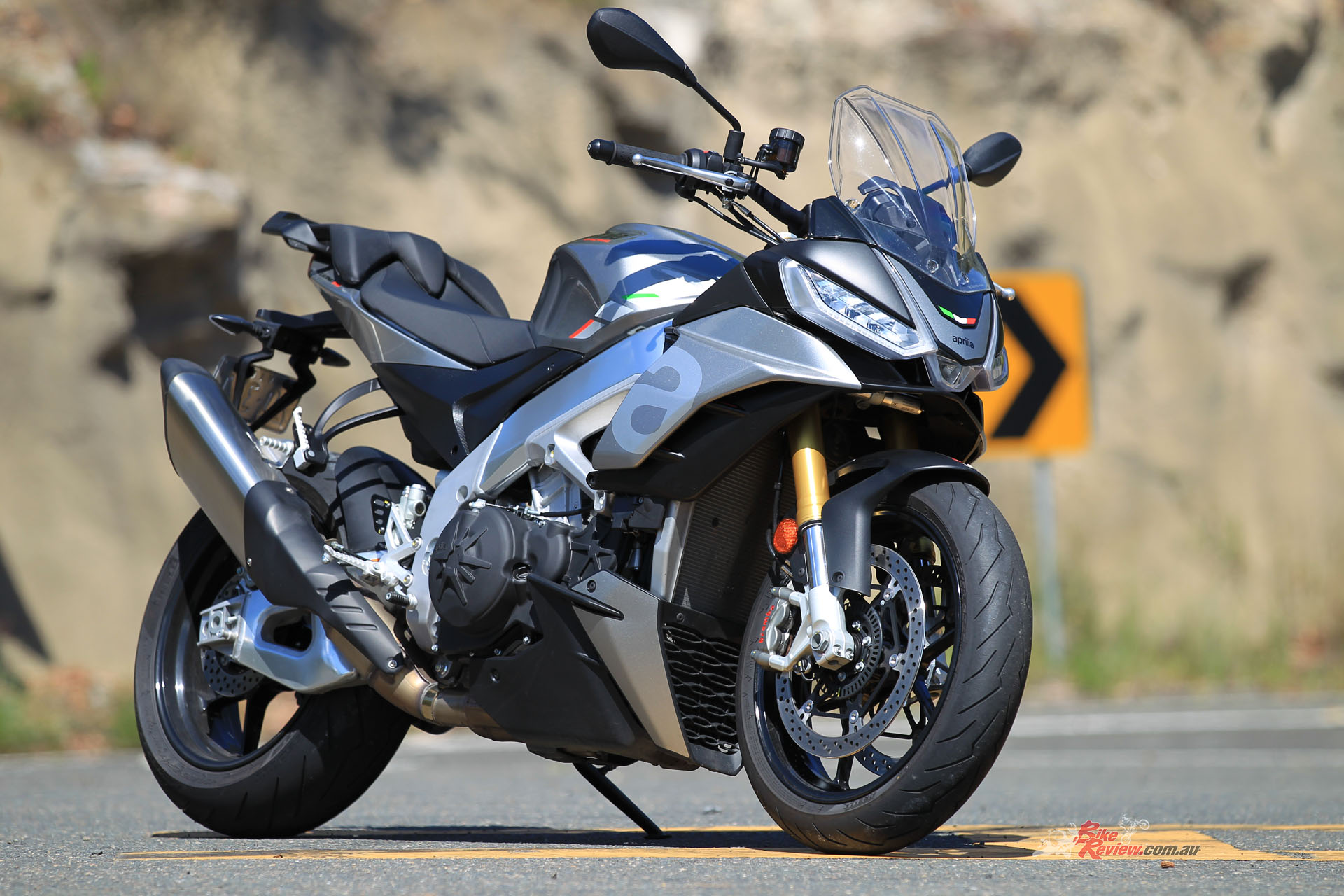
The new $28,830 Tuono V4 1100 has a taller screen and handlebars than the Factory, along with plusher Sachs suspension and lower pillion footpegs plus a more comfy seat.
I’ve always been an absolute fan of the mighty Aprilia Tuono. As far as I’m concerned, it is the Godfather of sports nakeds, the first true sportsbike with flat handlebars to come from Italy, or anywhere for that matter. I remember the first one I rode back when I was a very young Staff Journalist at Two Wheels magazine and Streetbike.
It truly blew my mind and to top it off, I was lucky enough to be riding one that was set up by the then Aprilia Australia tech, the talented Dave Ward. The bike was absolutely amazing on the road and the track, that big Twin power and the sports chassis was bliss. I still, to this day, think the old twin-cylinder Tuono models were some of the best road going nakedbikes Aprilia have made.
When the V4 arrived, I was mind blown yet again, but looking back on my testing, most of it was done at The Farm and when I was still racing, so generally looking for the performance edge of most bikes – this was prior to the recent years when I started, err, ageing and testing adventure bikes, scooters, cruisers and bought a Royal Enfield! I loved the on track but still felt the V2 was the better road bike. Well, perhaps not after riding the new, more road friendly, Tuono V4 1100… A few small tweaks and it could be a fantastic all-rounder nakedbike.
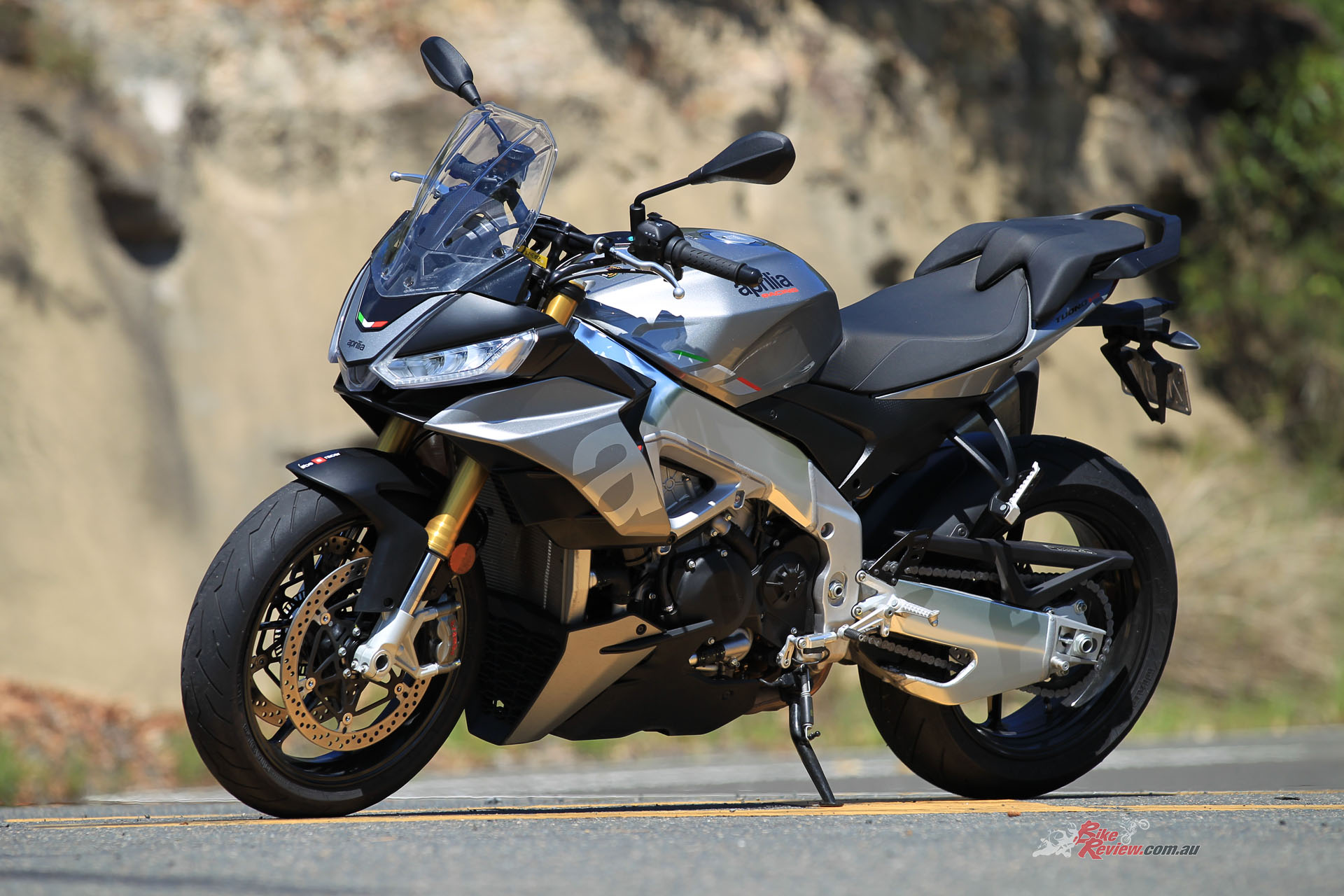
It’s not perfect, but the new Tuono V4 is a great bike with plenty of road potential. It’s super comfortable for a start.
Small adjustments make a huge difference at times and the taller handlebars and other differences between the V4 1100 and the Factory (see the Tech breakout below) means the the V4 is more comfortable and upright than previously. The new styling is on point, too, although you could argue whether it truly is a nakedbike anymore, given that there is a lot of real estate covered in bodywork and it has a big fairing. I’m a traditionalist, so I’m going to call it a semi-naked. It’s wearing a shirt but forgot to put its pants on… We’ve all been there, haven’t we?
Onboard the V4 1100, I immediately feel the changes to the earlier models. The bike has a more sports-touring view and the upright position makes me feel even further off the ground than before. With a high seat height, the tall handlebars and my long arms, I feel my head is up in the clouds and this takes a little time to get used to. The tank is wide at the top but narrow in the knee cutouts, and the reach to the handlebars is a long one. It’s a comfortable rider triangle, an all day position, but there is one glaring issue that has me scratching my head…
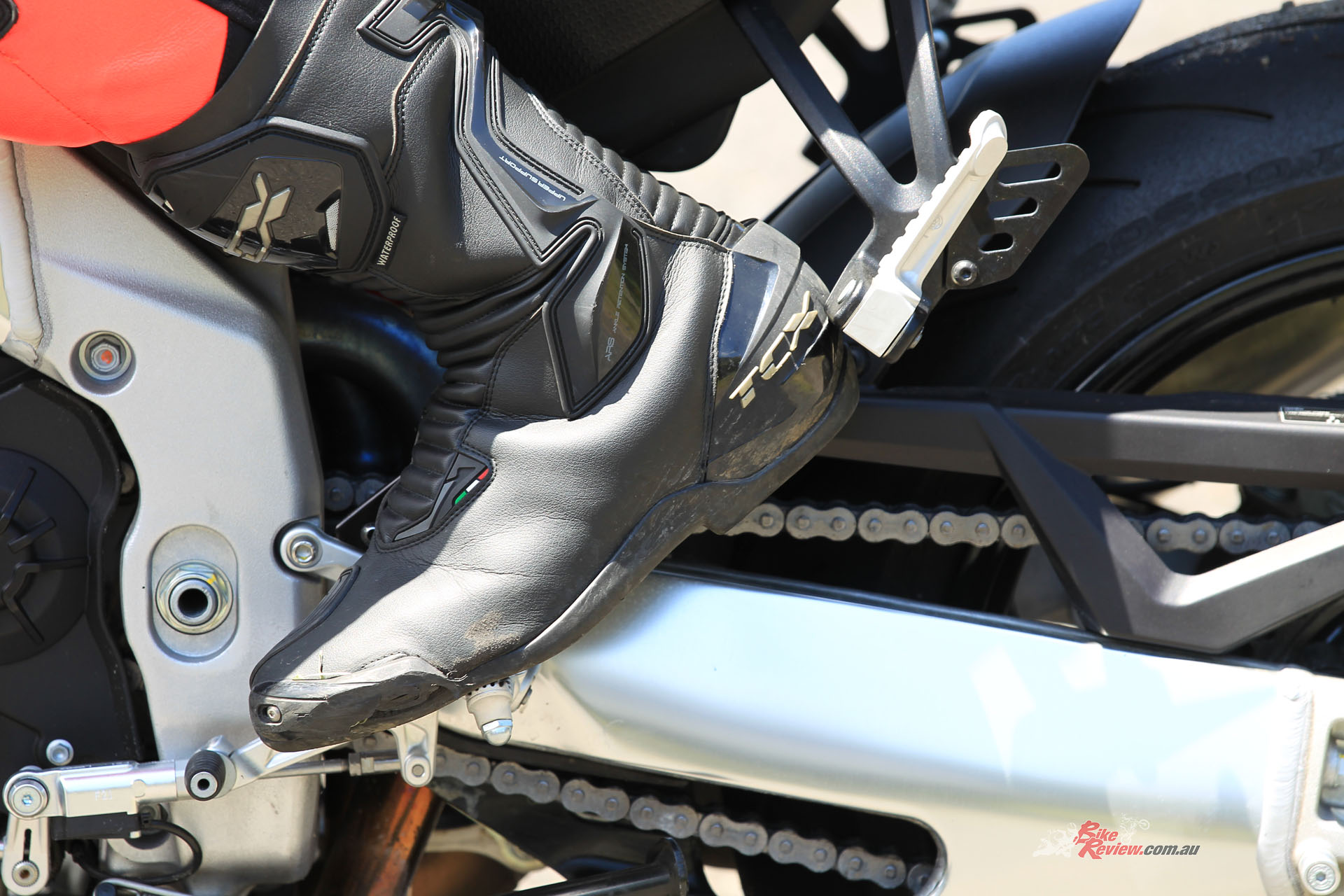
The pillion hangars are so low that they snag on my size 11 boots. I tried a few styles of boot but they all did the same thing. I almost crashed twice due to my heel getting stuck. It’s dangerous in my opinion and needs to be fixed.
There is not enough space between the rider footpegs and the pillion footpegs, causing a dangerous situation for me, with two near crashes during the photoshoot when my foot was completely stuck and I ran wide onto the wrong side of the road. Once I was hyper aware of the situation, I rode with my feet sticking out to stop the heel getting caught, but then my toes hit the road in the corners. I could not ride on the ball of my feet on the Tuono V4, which had a negative impact on the handling of the machine.
I would remove the pillion hangars immediately if it was mine. How did it pass the testing at the factory? With a large part of my own racing career on Aprilia motorcycles, including a championship and lap records, I do have a soft spot and appreciation for the Italian machines, so the design fault in the pillion hangars is a definite surprise, as Aprilia tend to get things right 99.9 per cent of the time.
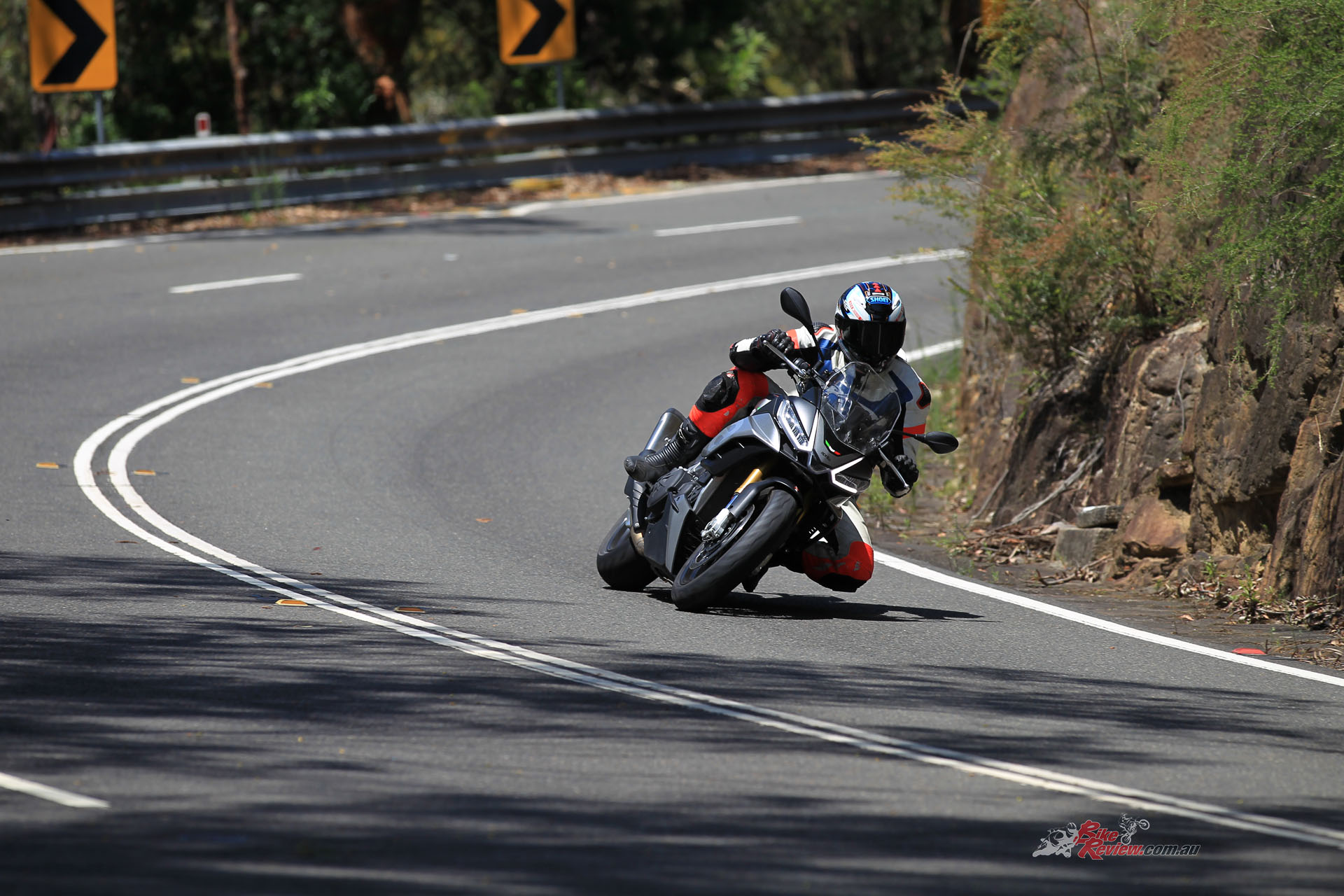
The new Tuono V4 1100 is a sweet handling motorcycle, with a good balance of comfort and support in the suspension and lovely geometry. It just needs a little more foot room! A very are glaring mistake from Aprilia with the boot clearance.
Heel clearance issues aside, the Tuono V4 boasts a sweet chassis with instantly recognisable racing DNA that makes me feel at home, and feel confident very quickly. The even more commanding than before riding position gives ultimate leverage on the wide handlebars, meaning total advantage of lightweight chassis can be put to work, while the rake feels sharper as a result.
With only 99.7mm of trail, you could expect less front feedback and grip from the Tuono but I think the softish Sachs forks add to the feeling that there is a larger footprint on the road. It is a communicative front-end, on or off the brakes, but braking needs to be done with finesse to avoid sudden fork dive. The geometry still makes the bike racy, even with stable steering and soft suspension. Of course, the plus side is the fantastic ride over bumps and undulations, giving real comfort, a first for a V4 Tuono!
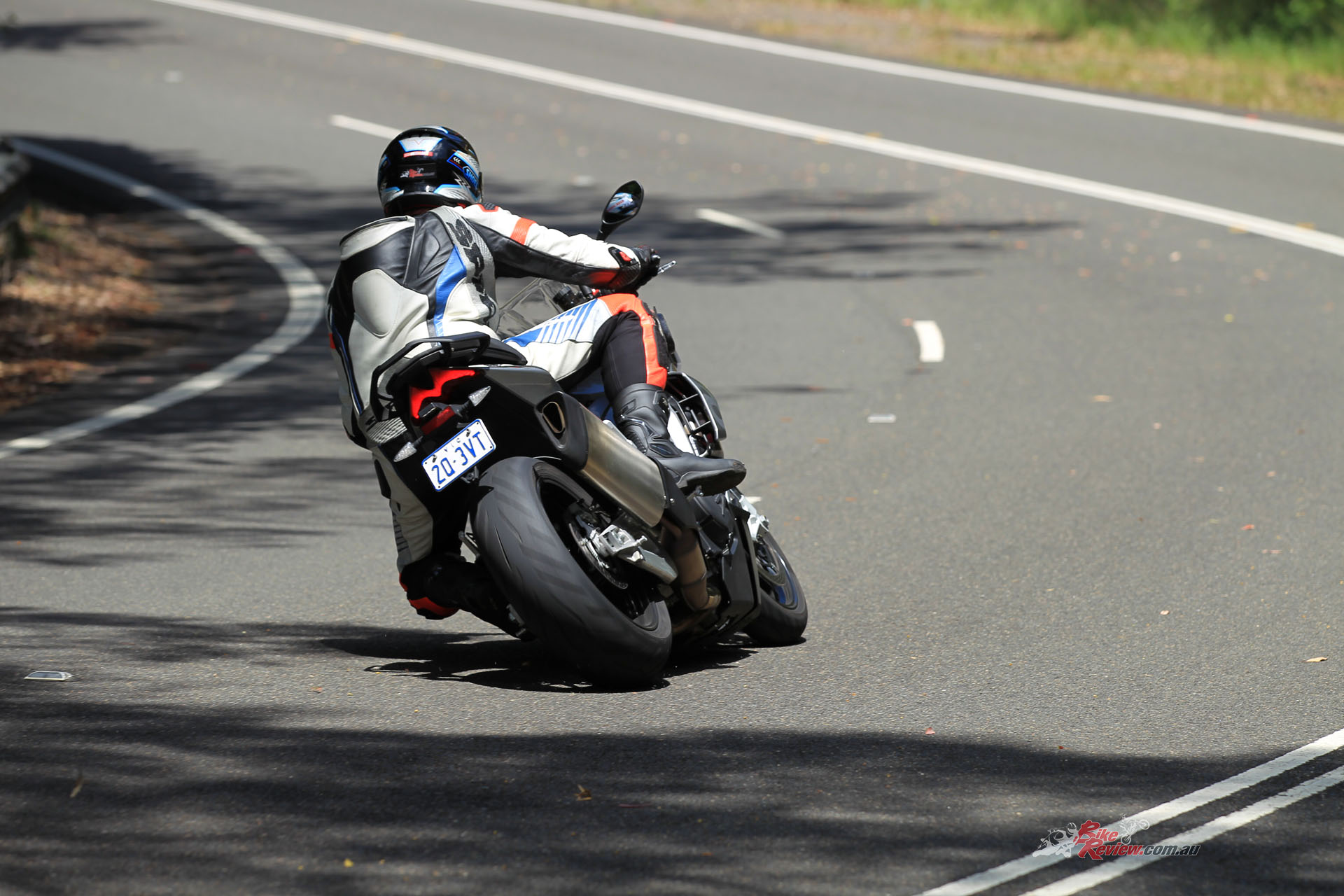
It is a communicative front-end, on or off the brakes, but braking needs to be done with finesse to avoid sudden dive.
The back end of the bike is similarly plush, with firm springs to give sporty support on the gas, coping with that whopping torque and power, and giving mid corner line holding, while still soaking up the crappy Australian country roads without the kidney punching of the old days. It’s a great balance from the Sachs set-up, and although it feels a bit soft and floaty at first, you soon realise how quickly you are actually going, while not suffering for the bumps!
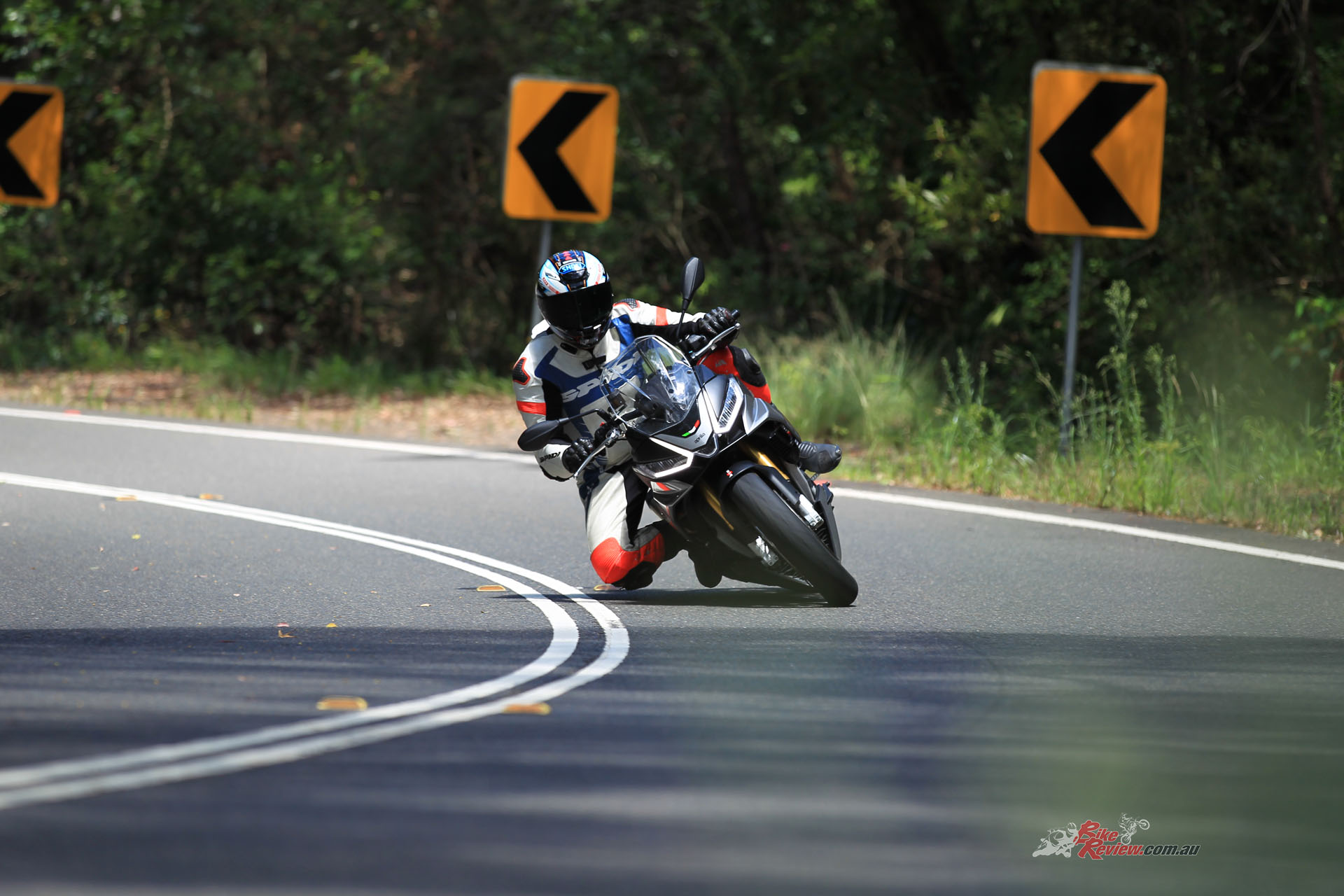
Soft enough suspension for country roads and sports touring, yet no problem doing this! A true versatile semi-naked.
Direction changes are quick and stable, but the Tuono is quite top heavy being a tall machine. A bit of effort at the ‘bars is required, but once on its side the bike is rock solid and give plenty of confidence-inspiring feel at both ends, even with that soft fork set-up.
Check out our previous Aprilia Tuono V4 1100 RR Video here…
You can carry good corner speed on the Tuono, but need a little rear brake to dampen that vicious punch from the engine on throttle opening if you want to keep the soft set-up balanced and poised. Ride it fast in the dry like you are riding fast in the wet, with gentle movements and finesse, and you are heavily rewarded by the race DNA of the sweet chassis…
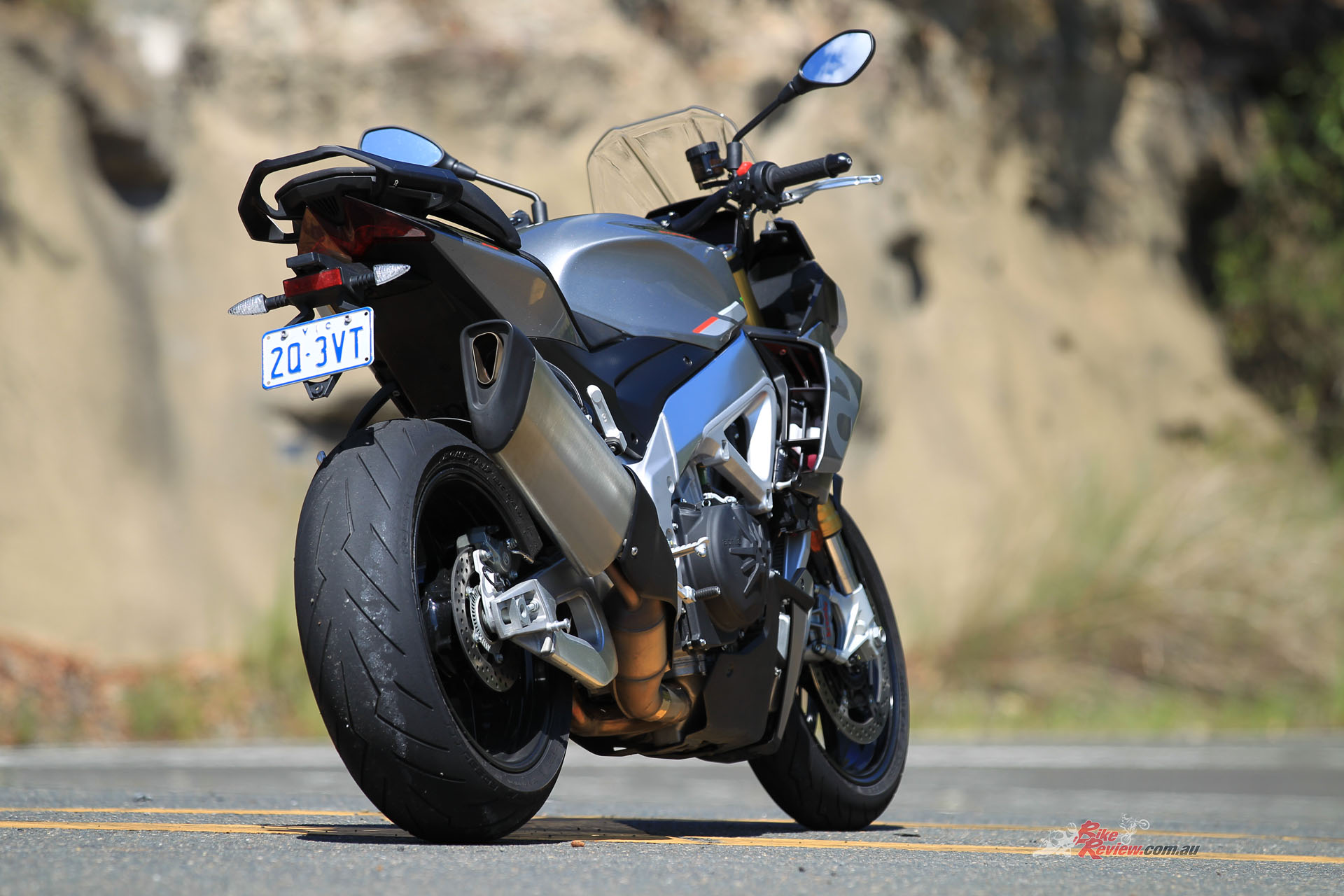
The V4 1100 has a 190 rear tyre, as opposed to the 200 on the Factory. I prefer the steering of the 190 rear myself.
Summarising handling, it’s comfortable and soft suspension-wise, possibly too soft for some really hard riding sports riders, but the geometry of the chassis allows the bike to get aways with the soft suspension and still steer and corner well, and even remain stable on the brakes. And the brakes are huge… We are talking standard suspension settings though, and I feel with a bit of extra preload and damping, within the stock availability, the Tuono could be just about spot on for a sports naked that needs to isolate the rider from our terrible, no horrendous, roads here in Australia…
One area that isn’t more ‘Touring’ or nakedbike easy are the brakes – they are still the same amazing units straight from the stunning RSV-4, the Brembo M50 calipers (drool) and massive 330mm front rotors (dinner plates), with a Brembo radial-pull master-cylinder up front and a 220mm rear rotor with a two-piston Brembo caliper controlling things out back. The front brakes are sensational, with brilliant feel and modulation, incredible power yet are great even at low speeds, while the rear is a little wooden in feel and could do with more power and less effort on the pedal.
The heart of the bike is of course that monster, loveable yet scary V4, which has been carefully adapted from the RSV4 to suit the nakedbike (see tech breakout below). Our info has come directly from Aprilia Australia’s tech department, as we found conflicting info on the bike from various sources including press kits and official websites, however, thanks to the team at PSI, we were able to get the exact info we needed to pass to you about the differences between the V4 1100, Factory, and the RSV4 engines and tune for the three applications.
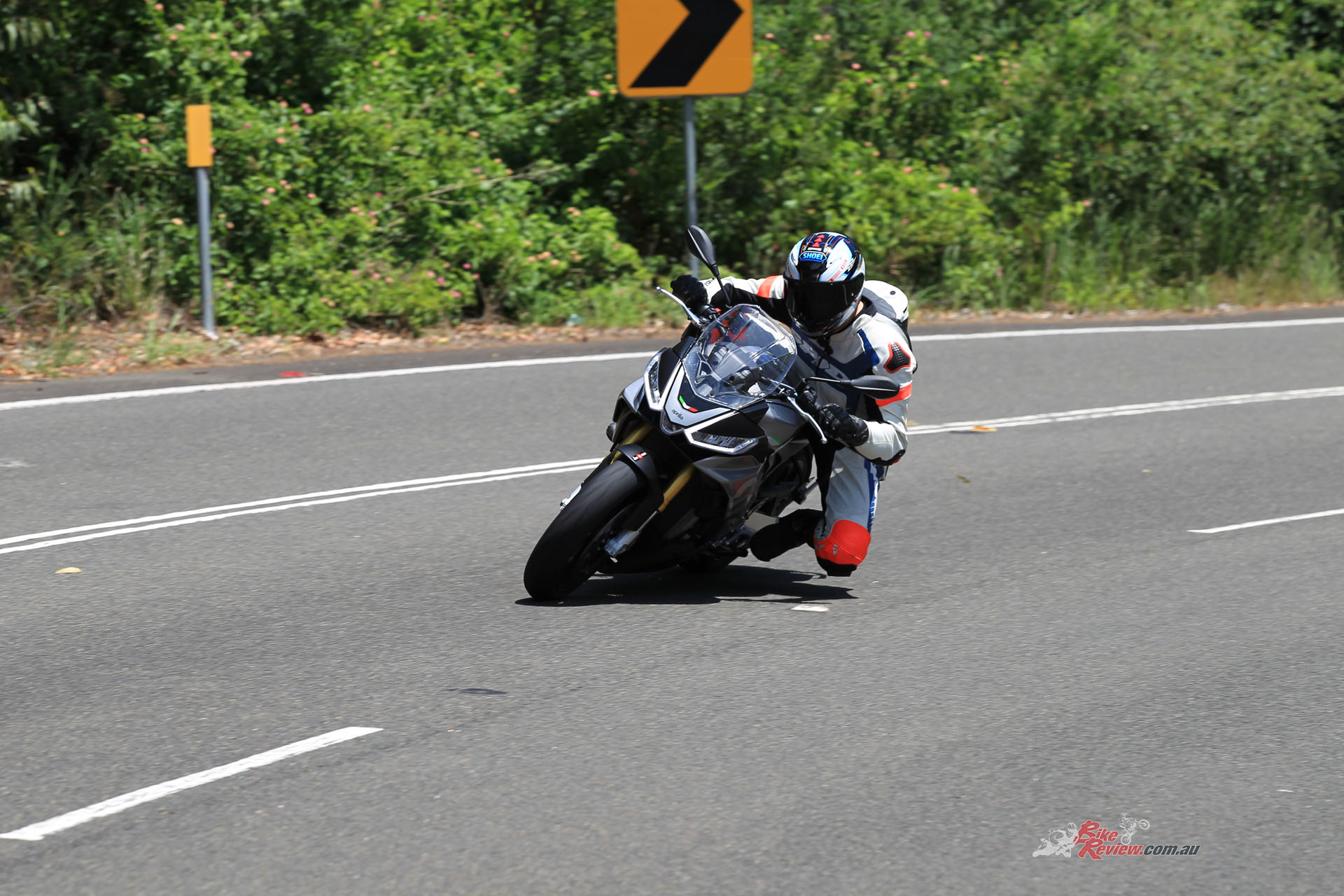
A wild motor shared with the RSV4 and the Tuono Factory is more than enough to keep you on your toes!
The engine is a beast, there is no other way to put it. No matter the mode, the map, the care with the right wrist, it is angry and blindingly quick. You need to be ready and committed when you open that RbW throttle and unleash the 175hp caged within the mighty V4. It’s agro, abrupt and not that refined and a real wild ride compared to some bikes in the naked class. It’s fast, really fast, and tractable. The gearbox is slick and the quickshifter reliable. The sensitivity of the throttle takes some time to get used to, as it is so touchy, but the bike can be ridden smoothly once you get used to it. There are six riding modes to choose from, I spent 90 per cent of the time on Sport.
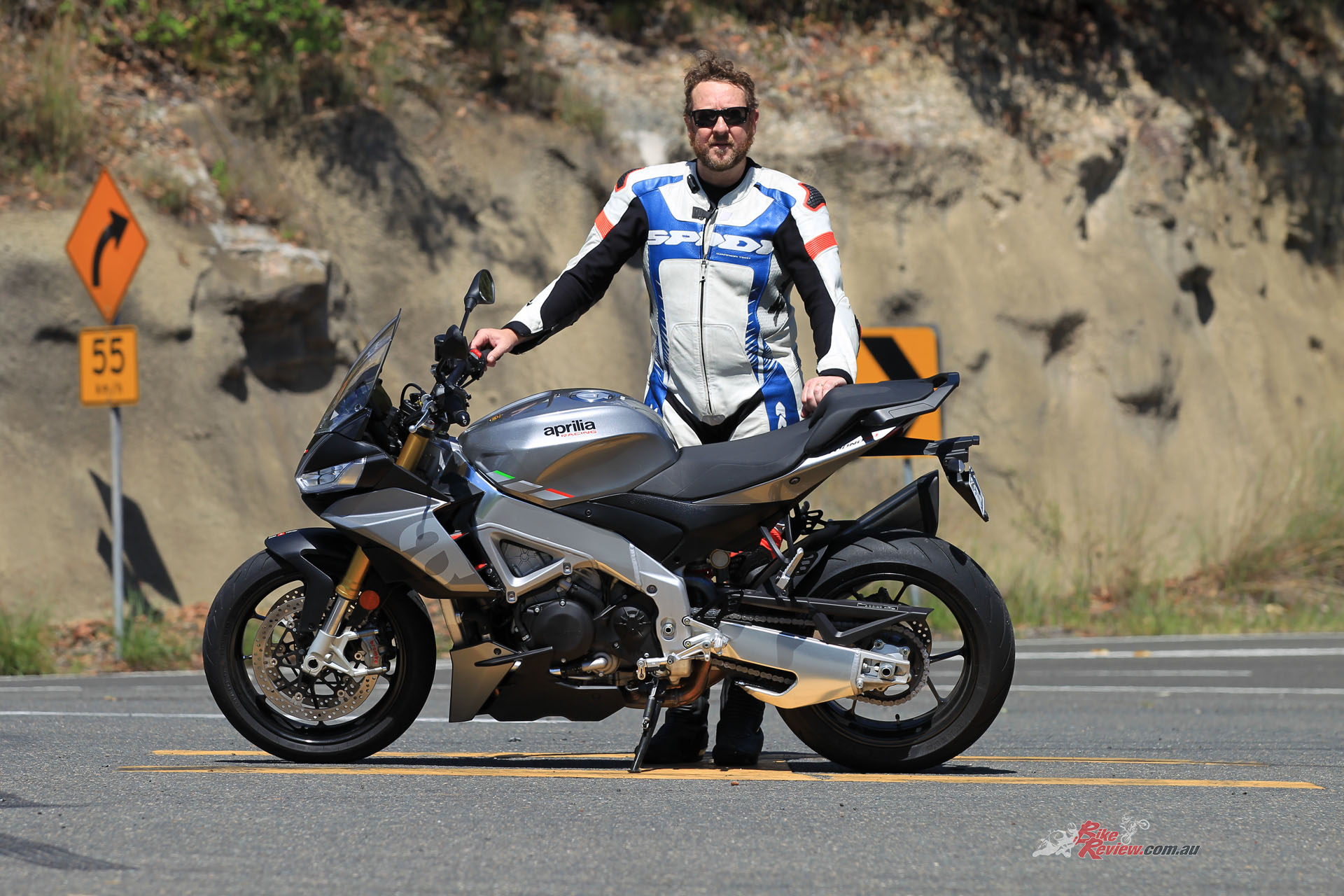
“Overall, the Tuono V4 is now much more of its own road bike, rather than a pure sports naked derived from the RSV4 and for hardcore sports riders. The few small comfort changes have made a big difference and made the Tuono much more tourable than it was before”…
There are so many advanced electronics on the Tuono V4 that it’d take an entire seperate article to cover them all so check out our breakout below and visit the Aprilia website for more on that. Overall, the Tuono V4 is now much more of its own road bike, rather than a pure sports naked derived from the RSV4 and for hardcore sports riders. The few small comfort changes have made a big difference and made the Tuono much more tourable than it was before… But still gives no end of thrills…
2022 Aprilia Tuono V4 1100 Specifications
Price: $28,830 R/A
Claimed Power: 129kW@11,000rpm
Claimed Torque: 120Nm@9,000rpm
Wet Weight: 209kg
Fuel capacity: 17.9L
Engine: Liquid-cooled 65-degree V4 16-valve DOHC, 1078cc, 81 x 52.3mm bore x stroke, 13.0:1 compression ratio, 48mm throttle-bodies, Marelli injection, Ride by wire, Four-into-two-into-one exhaust
Gearbox: Six-speed cassette type, straight cut gears, quickshifter
Clutch: Wet multiplate slipper clutch, cable actuation
Chassis: Aluminium dual beam chassis with pressed and cast sheet elements. Adjustment for headstock position and rake, engine height, swingarm pin height.
Rake: 24.8°
Trail: 99.9mm
Suspension: Sachs upside-down fork, adjustable, 43mm stanchions, 120mm travel (f) Sachs rear shock with progressive linkage, and adjustable spring preload, compression and rebound damping, 129mm travel (r).
Brakes: 330mm rotor(s) (f), Brembo M50 monobloc calipers, Brembo master-cylinders, 220mm rotor (r), twin-piston Brembo caliper
Wheels & Tyres: Cast alloy 3.50 x 17in, 6.00 x 17in, 120/70-17in, 190/55-17in
DIMENSIONS
Wheelbase: 1452mm
Seat height: 837mm
Overall width: 810mm
Overall Length: 2070mm
Overall height: 1170mm
Equipment: APRC (Aprilia Performance Ride Control) IMU-based traction control and cornering ABS,6 axis inertial platform, APRC suite (Aprilia Performance Ride Control) with Engine maps (AEM), Engine brake management (AEB), Traction control (ATC), Wheelie control (AWC), Launch control (ALC), Cruise control (ACC), Pit limiter (APT). 6 riding modes (3 Road, 3 Track), all individually adjustable, and three pre-set riding modes. Cruise control, TFT colour dash, up/down quickshifter.
Conclusion
It’s not a head-to-head winner takes all shootout, rather a comparison of two very different bikes from the same class that achieve similar goals. If they were drinks, the BMW would be a smooth red, creeping up on you, while the Aprilia hits you like a shot of the world’s strongest whisky. Both will end up getting you hammered, but the journey will be much different.
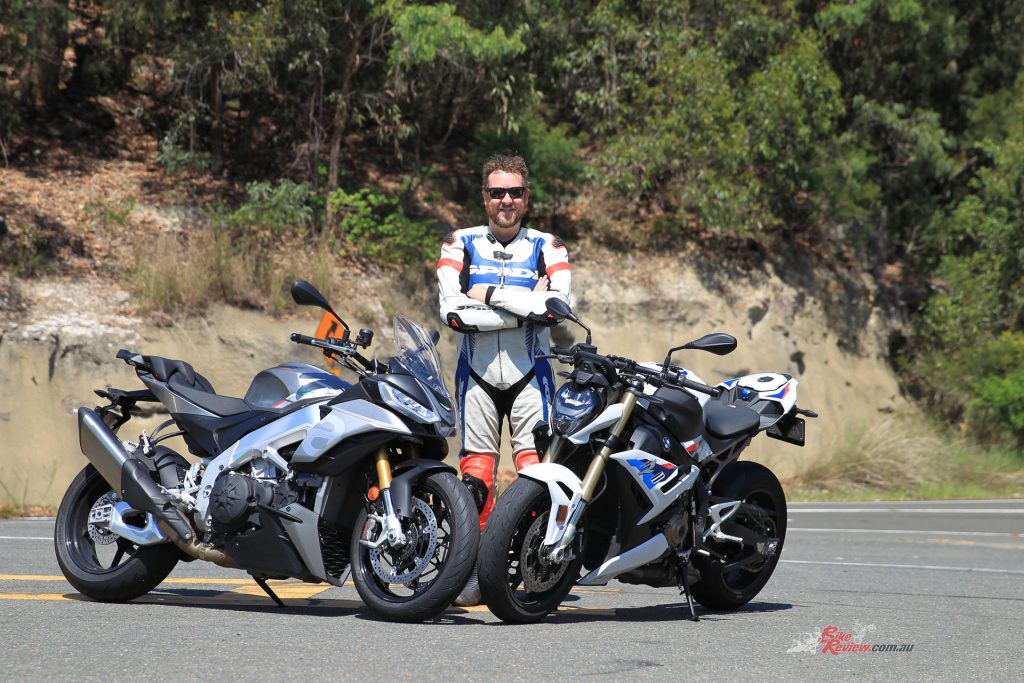 For me? I’d take the inline four. I like the power delivery and as much as the vibes annoy me, I can live with that over the aggressive nature of the Aprilia, and I’m still comfy on the BMW. If I was doing big Interstate trips, it might be another story. But that is just me… Really, you need to ride both to decide….
For me? I’d take the inline four. I like the power delivery and as much as the vibes annoy me, I can live with that over the aggressive nature of the Aprilia, and I’m still comfy on the BMW. If I was doing big Interstate trips, it might be another story. But that is just me… Really, you need to ride both to decide….
BMW S 1000 R M-Sport Tech Talk
The in-line four-cylinder engine of the S 1000 R is now based on the engine of the current generation S 1000 RR and makes an impressive 121kW (165hp) at 11,000rpm. Maximum torque of 114Nm is available at 9,250rpm. The engine speed range has been made wider and fuller to achieve improved rideability with a particularly linear torque curve.
In order to reduce noise and fuel consumption levels as well as the engine speed level – especially at cruising speeds on country roads – 4th, 5th and 6th gears now have longer gear ratios. In addition to a smoother, self-reinforcing anti-hopping clutch, the new bike is equipped with engine drag torque control (MSR) for the first time. Engine drag torque control prevents the rear wheel from slipping as a result of abrupt throttling or downshifting thanks to its electronic actuation.
The chassis was also subjected to significant weight reduction in a bid to improve performance and engagement. The frame and swingarm are based on the S 1000 RR and have been made considerably lighter than those of the previous generation model.
At the same time, the engine in the Flex Frame takes on a much greater supporting function than before. The new frame offers further benefits due to its very narrow design, reducing the motorcycle’s width in the area of the knee contact area. This enables a more relaxed riding position with even more freedom of movement, according to BMW.
The underslung swingarm has been adopted from the S 1000 RR, while the spring strut with Full Floater Pro kinematics is now located significantly further away from the swing axis and engine. This prevents the shock from heating up due to waste heat and ensures even more stable temperature behaviour and more constant damping response. In combination with the swingarm, which has its roots in motorsports, this results in more tyre grip and lower tyre wear, BMW claim.
The new S 1000 R is equipped as standard with Dynamic Traction Control DTC, ABS Pro with banking angle optimisation and the three riding modes: Rain, Road and Dynamic. The fully configurable Dynamic Pro mode is also available with a particularly wide range of setting options as part of the Riding Modes Pro option.
With Riding Modes Pro, the new S 1000 R also features the Engine Brake function in conjunction with the engine drag torque control (MSR) and the Power Wheelie function. As part of the Riding Modes Pro option, Dynamic Brake Control (DBC) additionally supports the rider during emergency braking manoeuvres.
The new S 1000 R takes on the instrument cluster of the S 1000 RR. Special emphasis was placed on the best possible readability in addition to an extended range of functions and information. The screen was therefore designed to be large for clear readability and provide optimum information display even under difficult lighting conditions.
The rider can choose between customised screen displays for various purposes. The Pure Ride Screen, for example, provides all necessary information for normal road riding, while a further Core Screen shows displays for banking angle, deceleration and traction control.
A Bluetooth smartphone interface, which allows app-based arrow navigation, is already included as standard. The TFT display is operated comfortably from the handlebars using the multi-controller, while the optional M package provides a third Core Screen with bar display and lap timer.
The lighting units of the new S 1000 R are based on state-of-the-art LED technology. These include the new, striking LED main headlamp with optimised low beam and high beam light. The newly designed turn indicator and rear lights also make use of LED technology.
The rear turn indicators have been adopted from the S 1000 RR and feature an integrated tail/brake light function. Enhanced safety when riding at night is ensured by the adaptive turning light, which is a component of Headlight Pro.
2022 Aprilia Tuono V4 1100 Tech Talk
The 1,077cc V4 from Veneto remains unchanged in terms of its performance. The Tuono has the same 81mm bore/52.3mm stroke and 48mm throttle-bodies as the RSV4, but loses the two injectors per cylinder, and receives a lower compression ratio, of 13:1, down from 13.6:1 on the RSV4.
Aprilia have kept the street in mind when it came to the tune on the Tuono. Compared to the RSV4, the naked version makes peak power 2,200rpm lower at 11,000rpm. Power has also been decreased to 175hp to 217hp, all changes that make the bike less of a monster to ride everyday. The new high resolution engine speed and crank position sensing system (Special flywheel with precision pickup and new software) mitigates random misfiring, improving fuel emissions, engine efficiency while making more power for the same fuel.
The Tuono V4 includes changes for 2022 that continue along the theme of a more comfortable option compared to the RSV4 or Factory Tuono. Aprilia have put specific focus on improving the comfort provided by the raised handlebar and making a more protective top fairing. They haven’t left the passenger out of the update, revising the rear seating position and footpegs to ensure they stay comfortable when riding pillion.
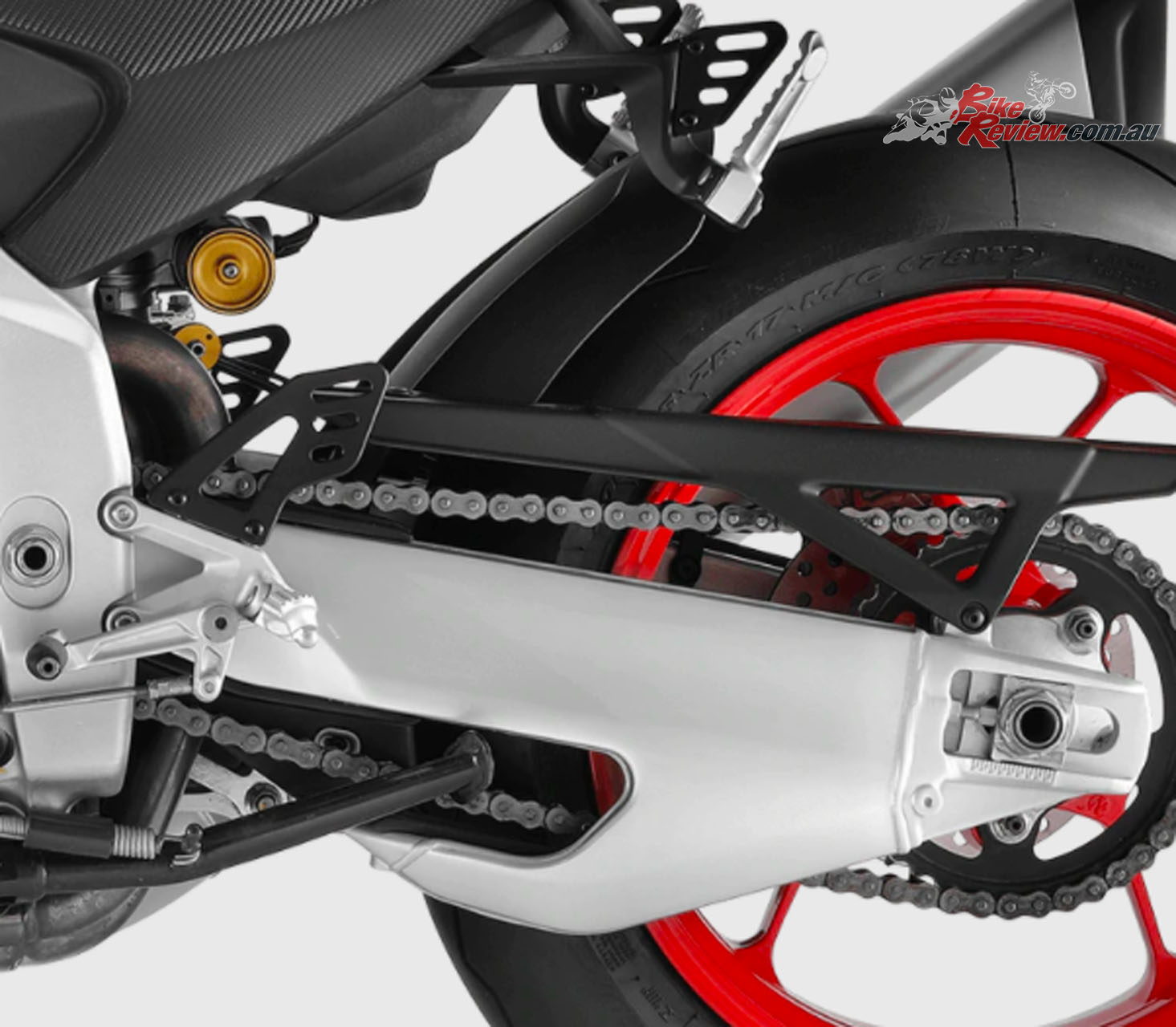
The new swingarm is the star of the show. It has been completely revised for more performance and stability…
The chassis architecture evolves significantly thanks to the arrival of a new and lighter aluminium swingarm with lower reinforcement brace. The new swingarm adopts a geometry that has already been seen on the WorldSBK and MotoGP Aprilia bikes. The new swingarm has been designed to lower the weight and increase the stability of the rear end in acceleration.
The front Brembo braking system comes directly from the one on the RSV4 and relies on a pair of 330mm steel discs, gripped by the Brembo monobloc M50 callipers and activated by a radial master-cylinder on the handlebar. The rear is sorted by a 220mm steel disc with Brembo two-piston caliper…
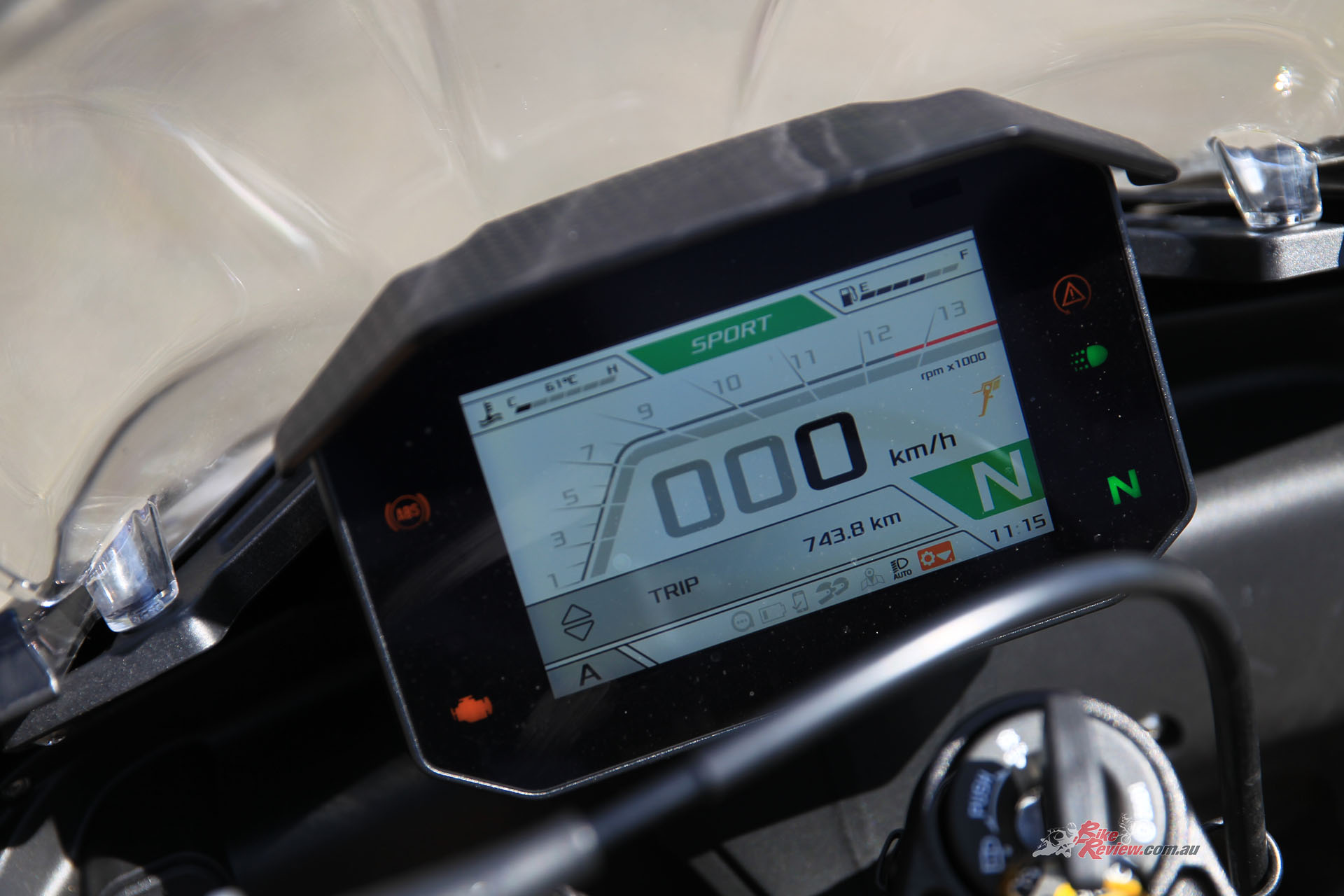
The new colour TFT instrumentation is larger and more complete, making information easier to see on the fly.
The new colour TFT instrumentation is larger and more complete. Thanks to the more powerful new Marelli 11MP ECU and new, six-axis inertial platform, electronic management using the full Ride-by-Wire throttle has improved and the APRC (Aprilia Performance Ride Control) operating logic has also been refined.
The new Marelli 11MP engine ECU now features four times the processing speed and four times the memory compared to the previous Marelli 7SM. Among other things this allows much higher data sampling rates and more precise fuelling and engine control. Room for more rider functions too.
The exclusive Aprilia electronic controls suite, is now even more enhanced with the introduction of the adjustable engine brake control. There are now six Riding Modes, three for the track (including two customisable) and three for the road (including one customisable): the rider just needs to choose the Riding Mode that best interprets their riding needs to automatically obtain the best settings in terms of Traction Control, Wheelie Control, engine brake, ABS and the other managed parameters.
The Tuono V4 is fitted with a multimap Cornering ABS system, developed in collaboration with Bosch. The 9.1 MP system is able to optimise braking and the ABS intervention in corners, thanks to a specific algorithm that constantly monitors various parameters such as lateral acceleration, the pressure applied to the front brake lever, the lean, pitch and yaw angle, modulating the braking action in order to better guarantee the ratio between deceleration and stability. The ABS works in unison with the Aprilia RLM (Rear Liftup Mitigation) system that limits the lift of the rear wheel during more abrupt braking.
The Tuono V4 wears its typical top fairing that houses the new triple LED headlight unit with DRL lights featuring the “bending lights” function, the headlights will automatically adjust when cornering to allow for maximum vision. Being closely derived from the RSV4, the Tuono V4 also benefits from the new and refined ergonomics of the Aprilia superbike that provides more space for a better on-board fit for the rider, thanks to the new shape of the fuel tank and tail fairing.
Editor’s Note: If you are reading this article on any website other than BikeReview.com.au, please report it to BikeReview via our contact page, as it has been stolen or re-published without authority.


